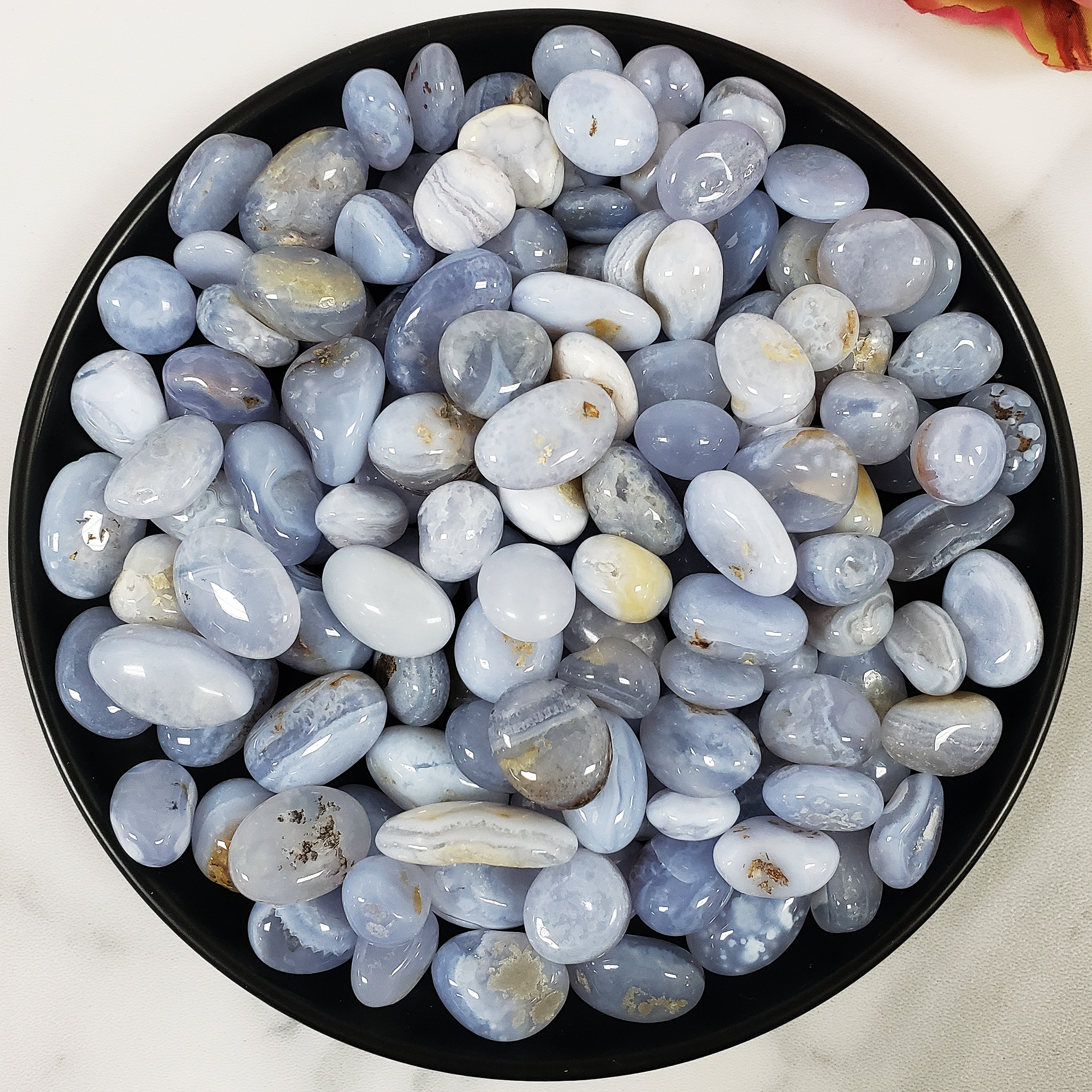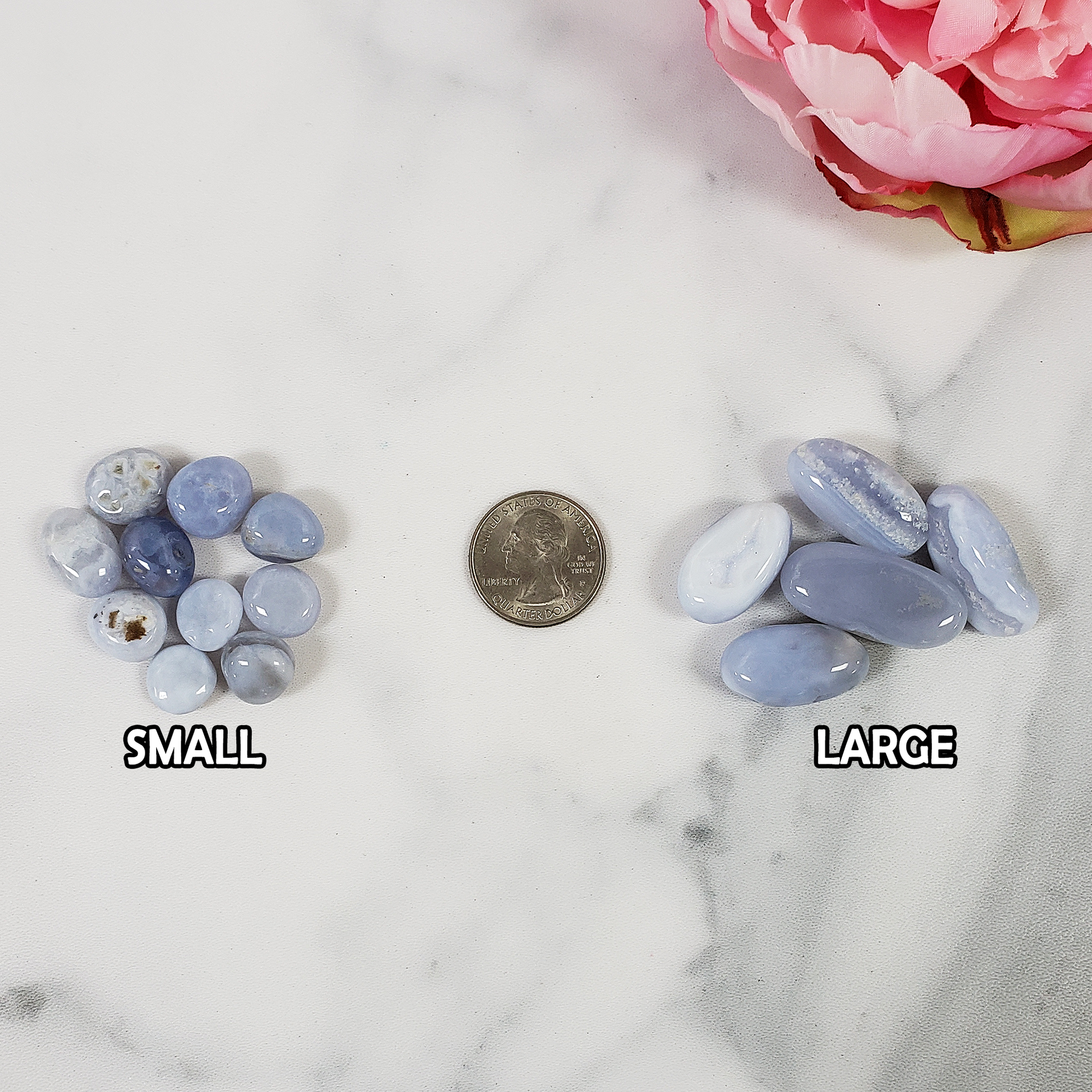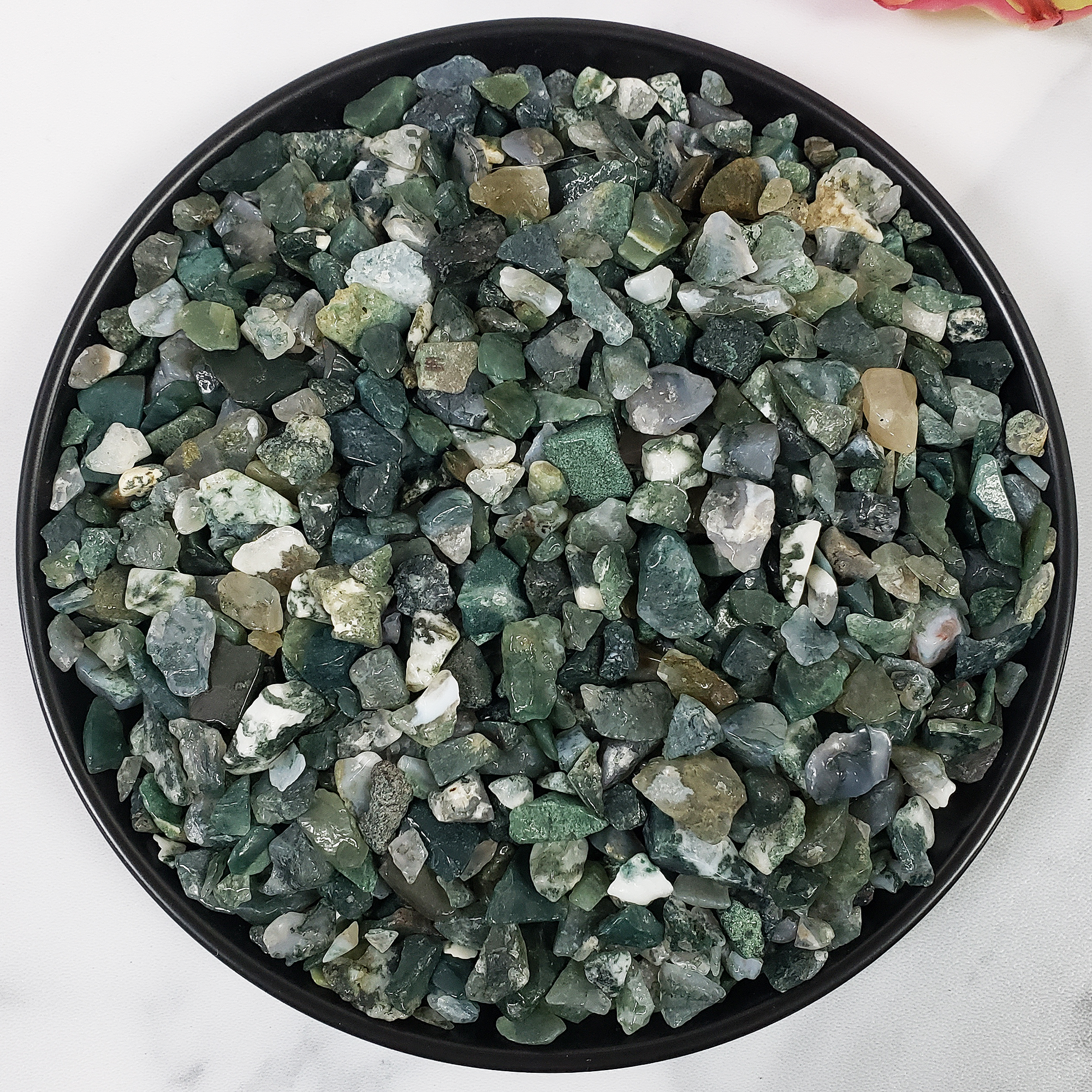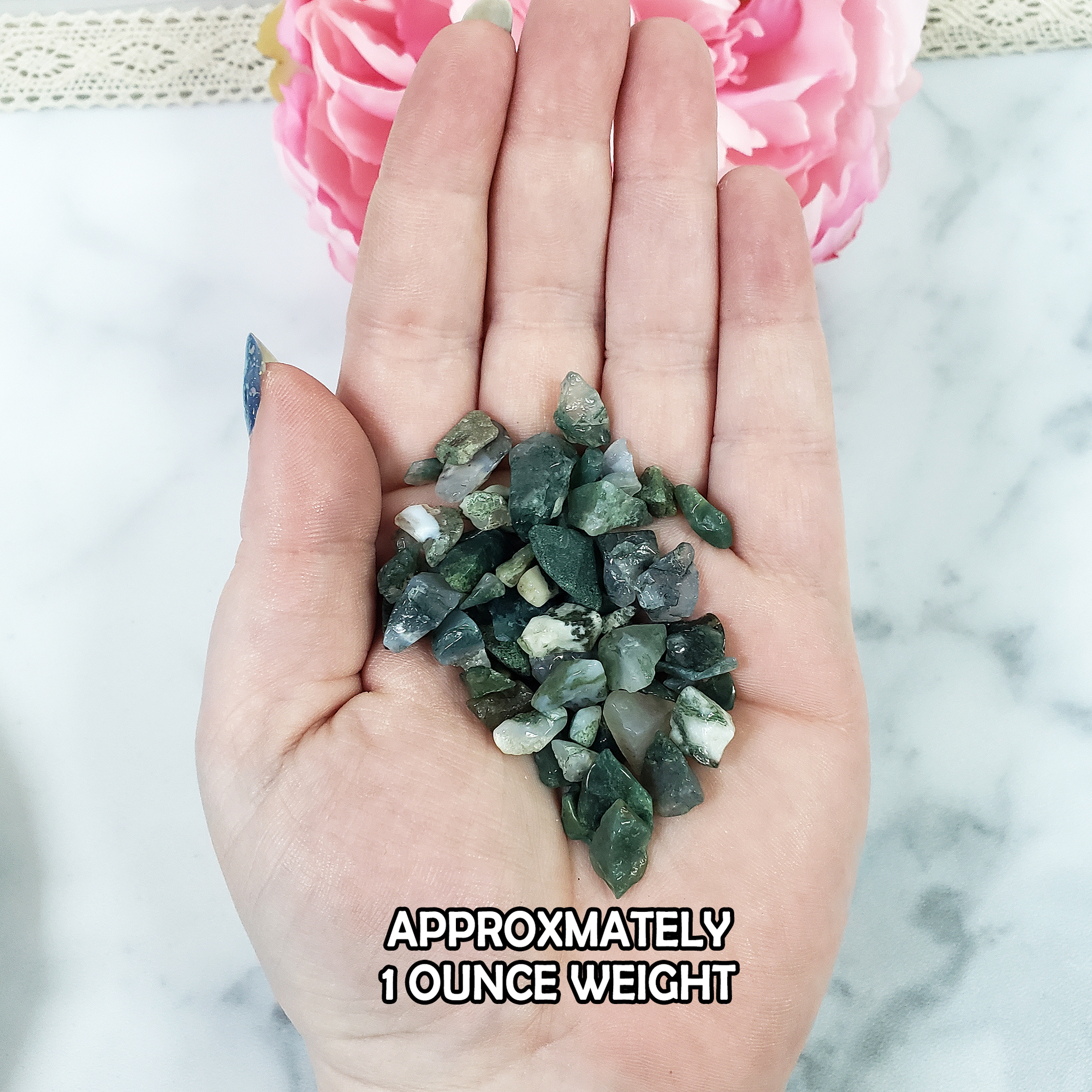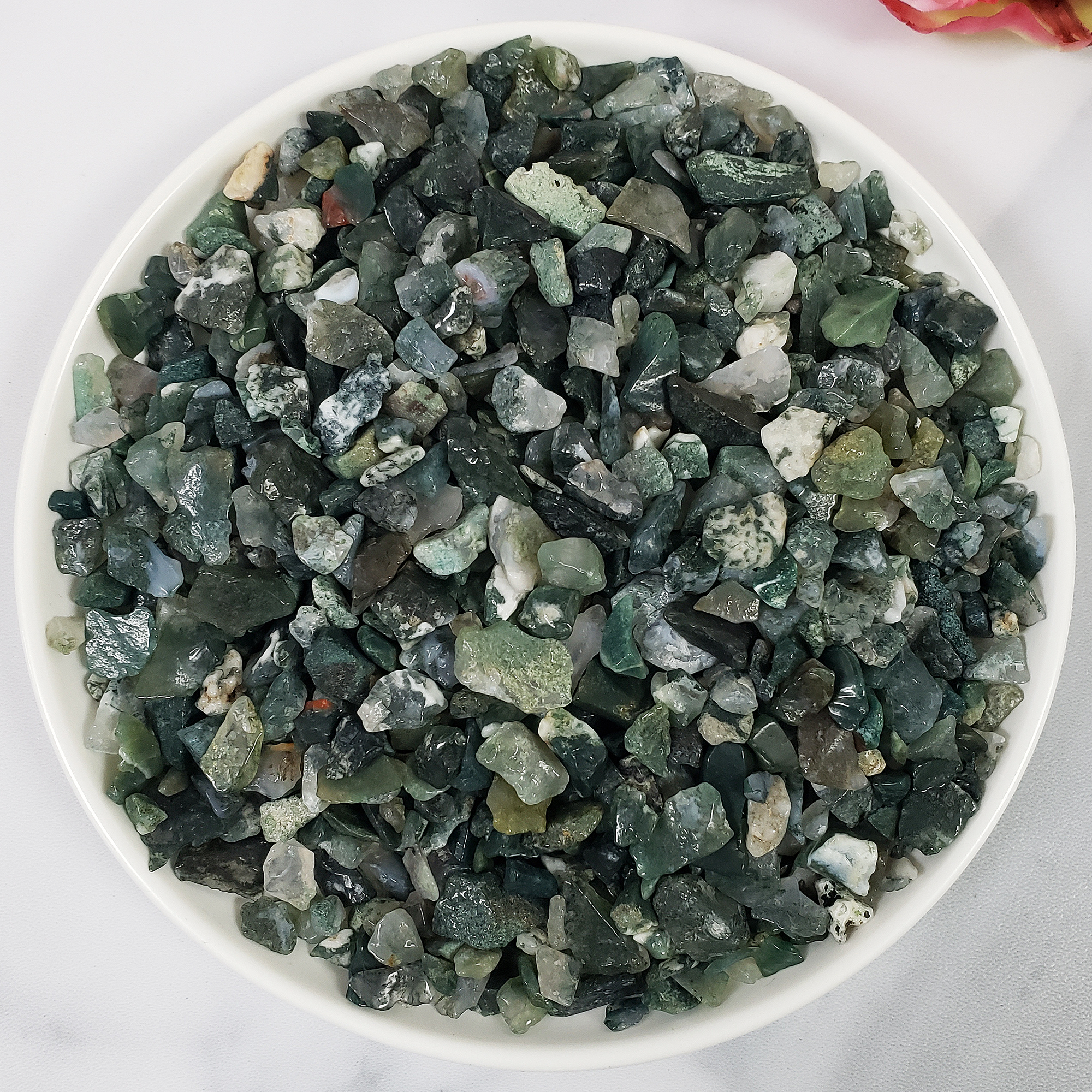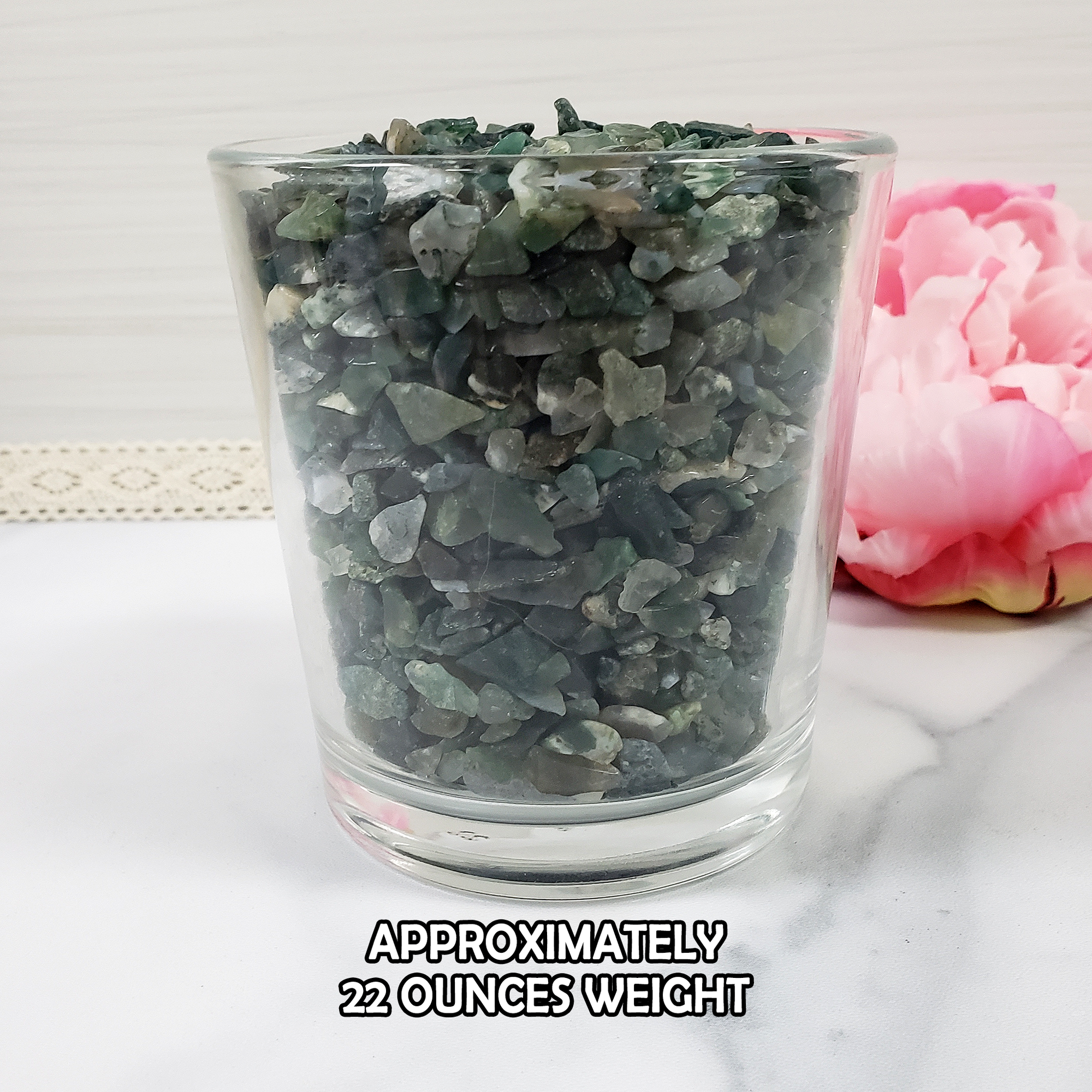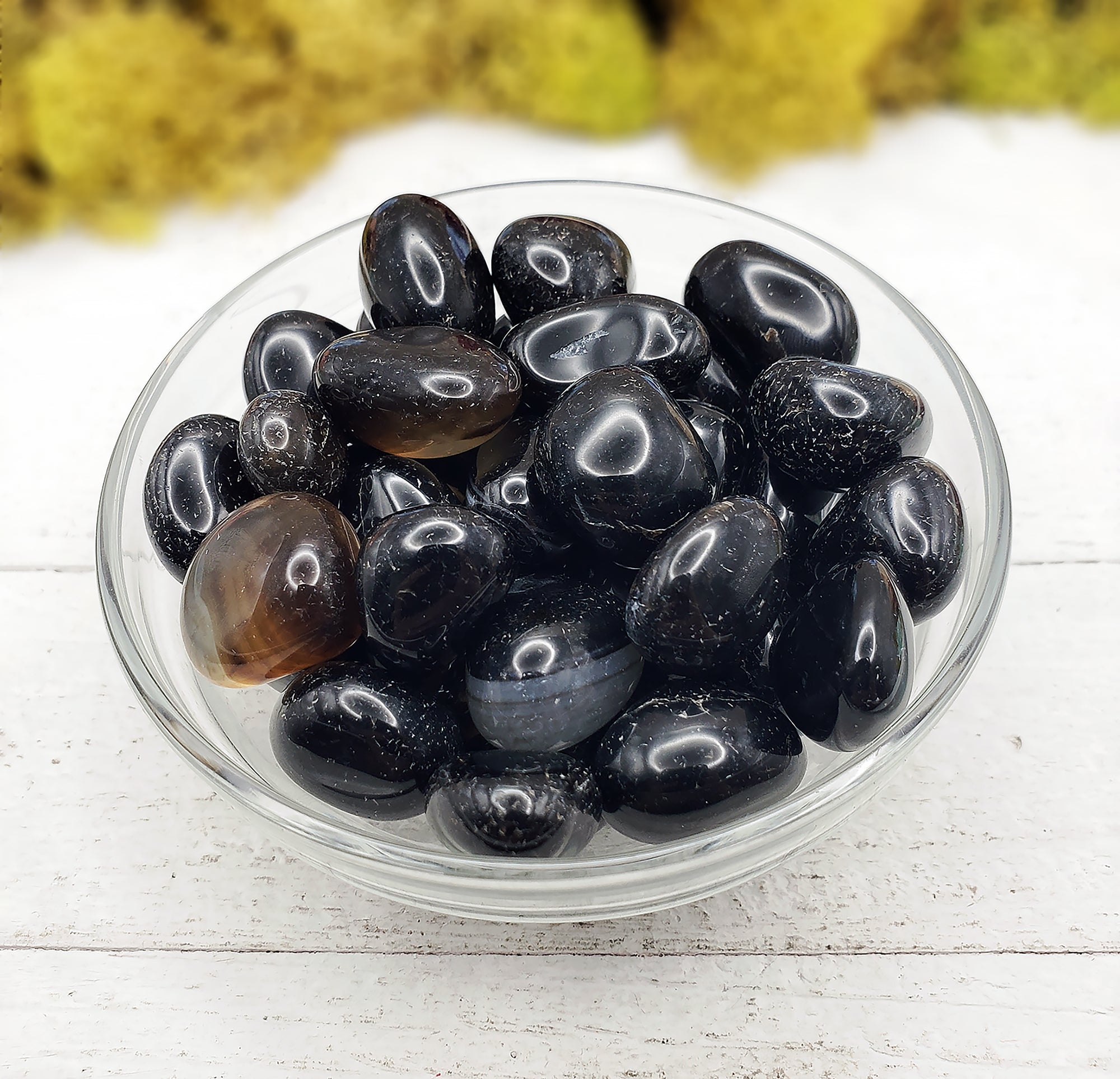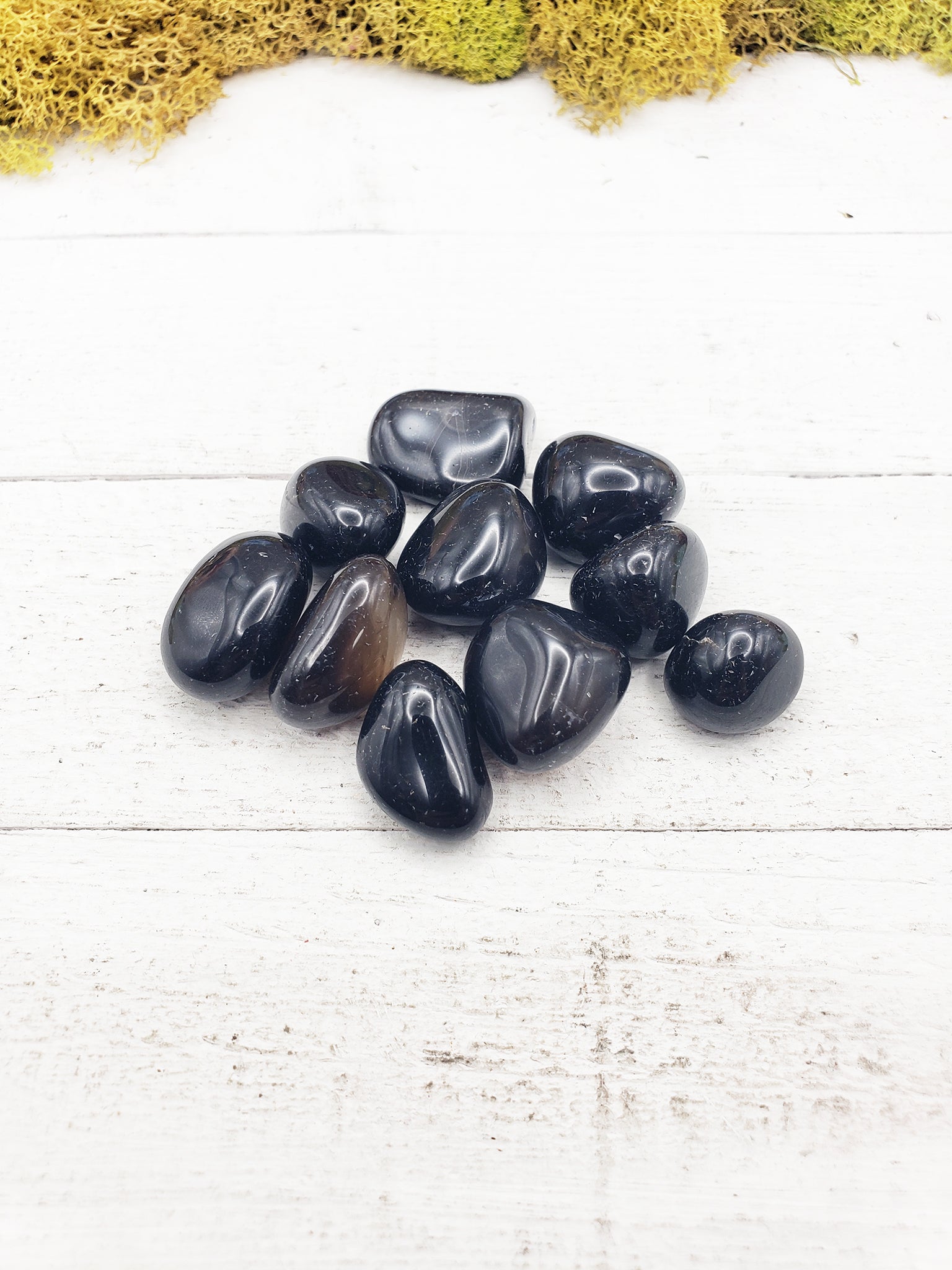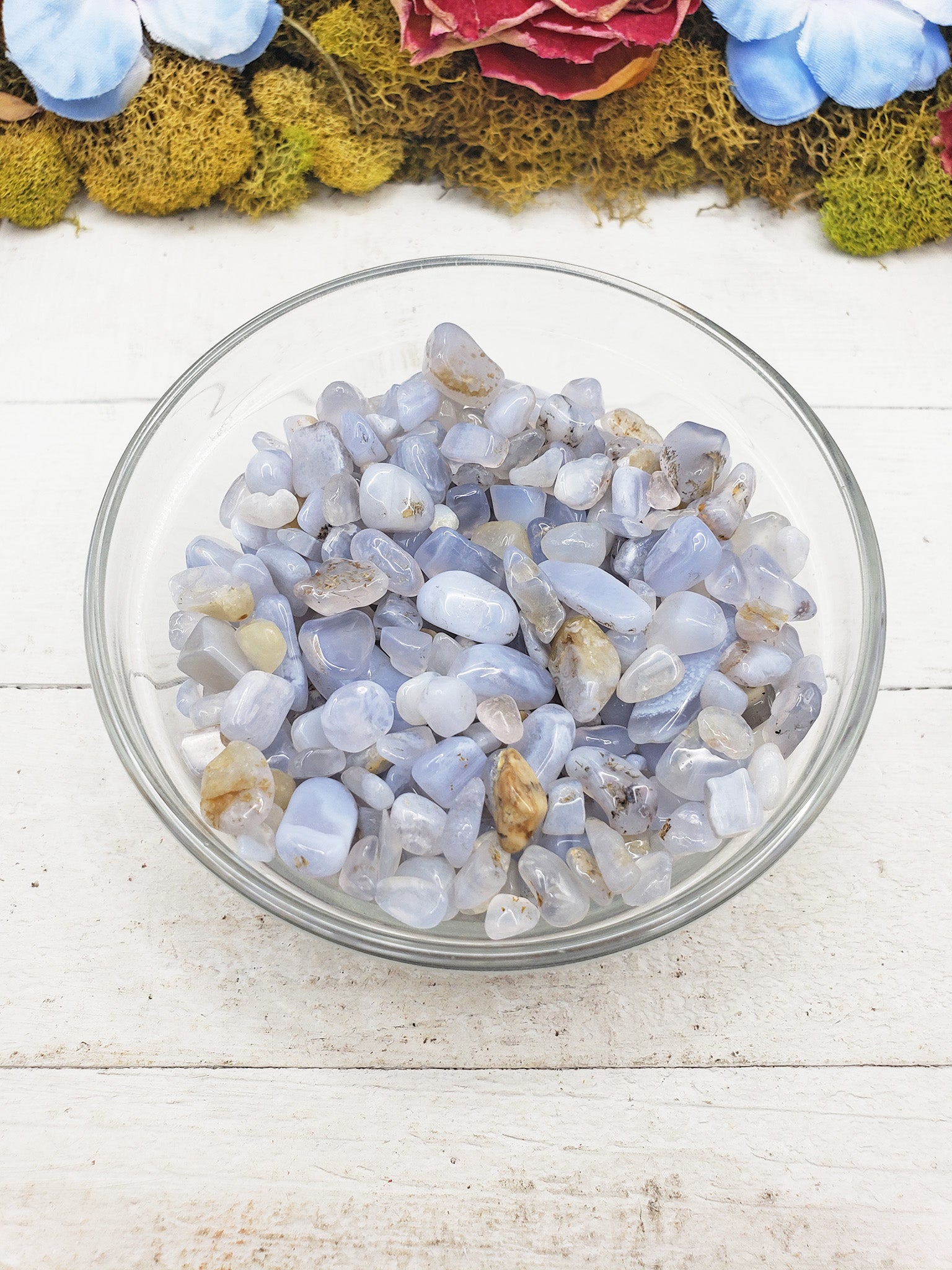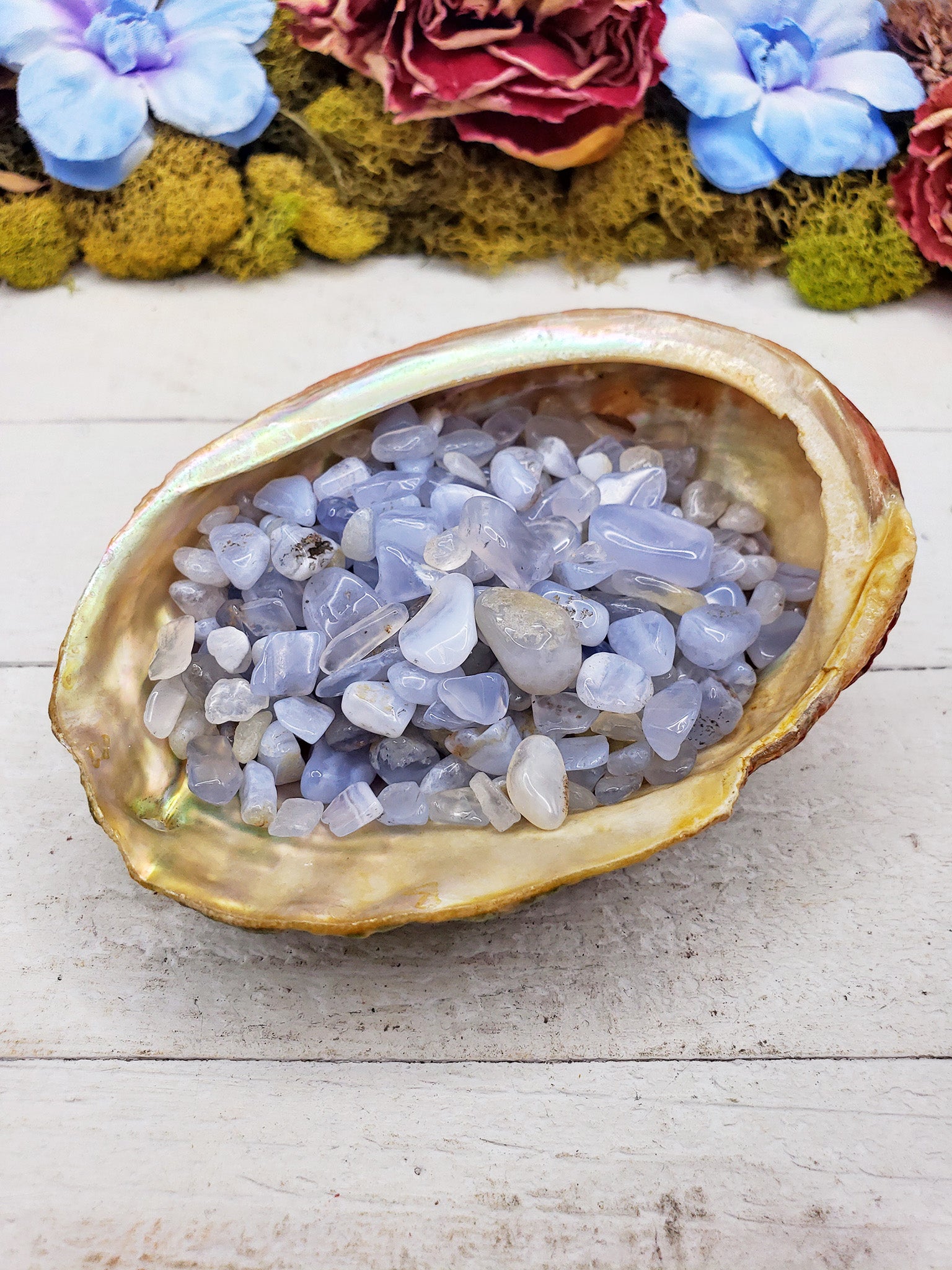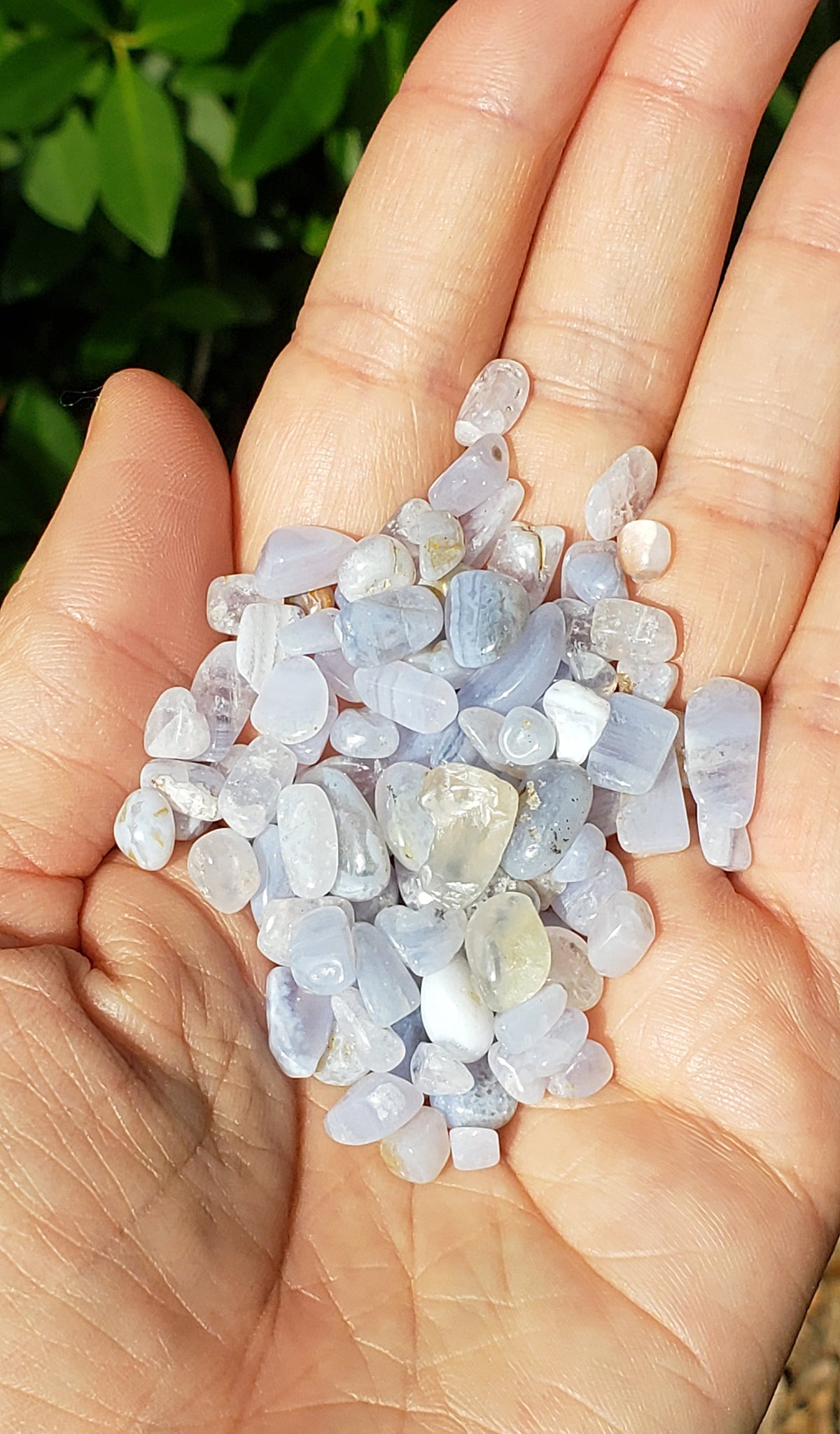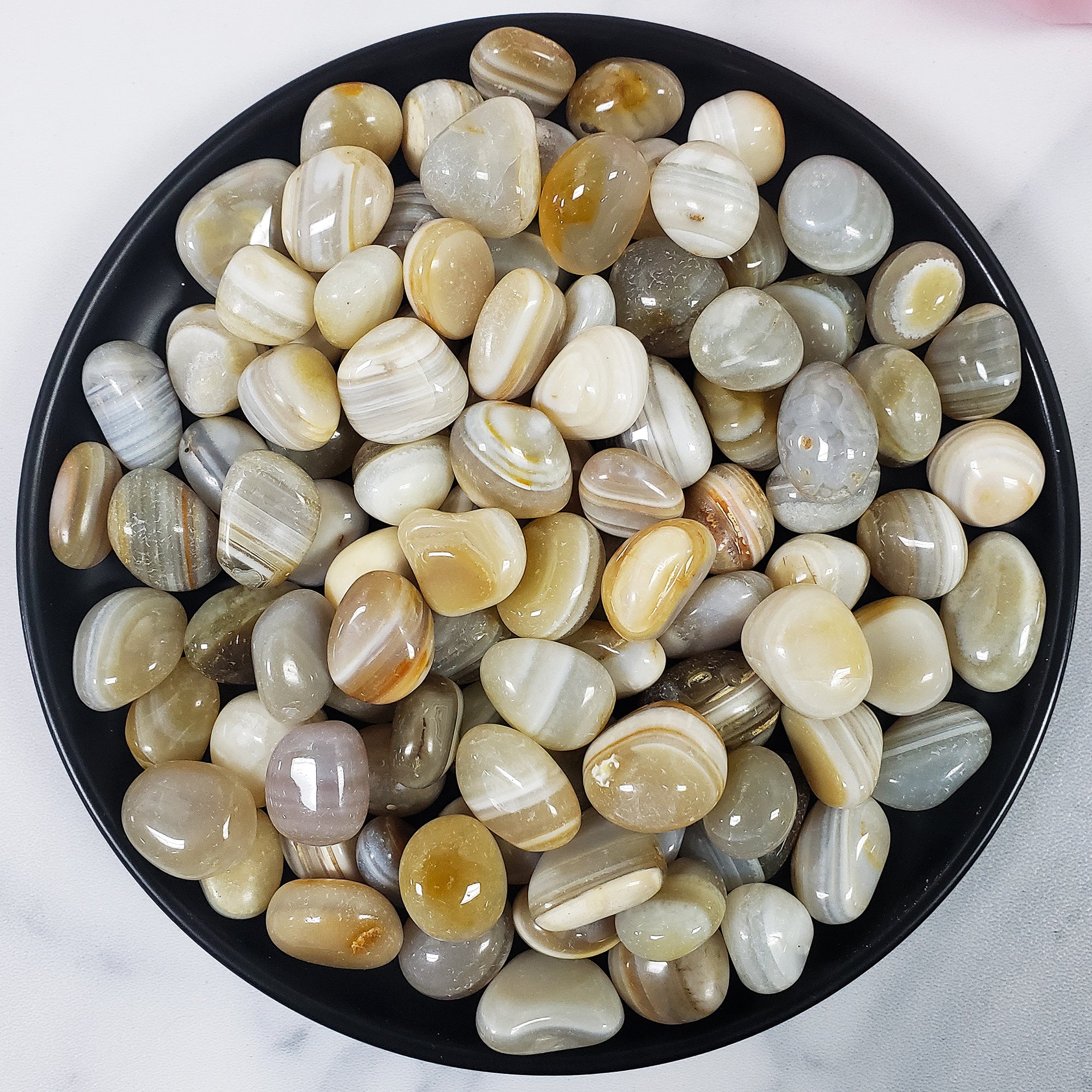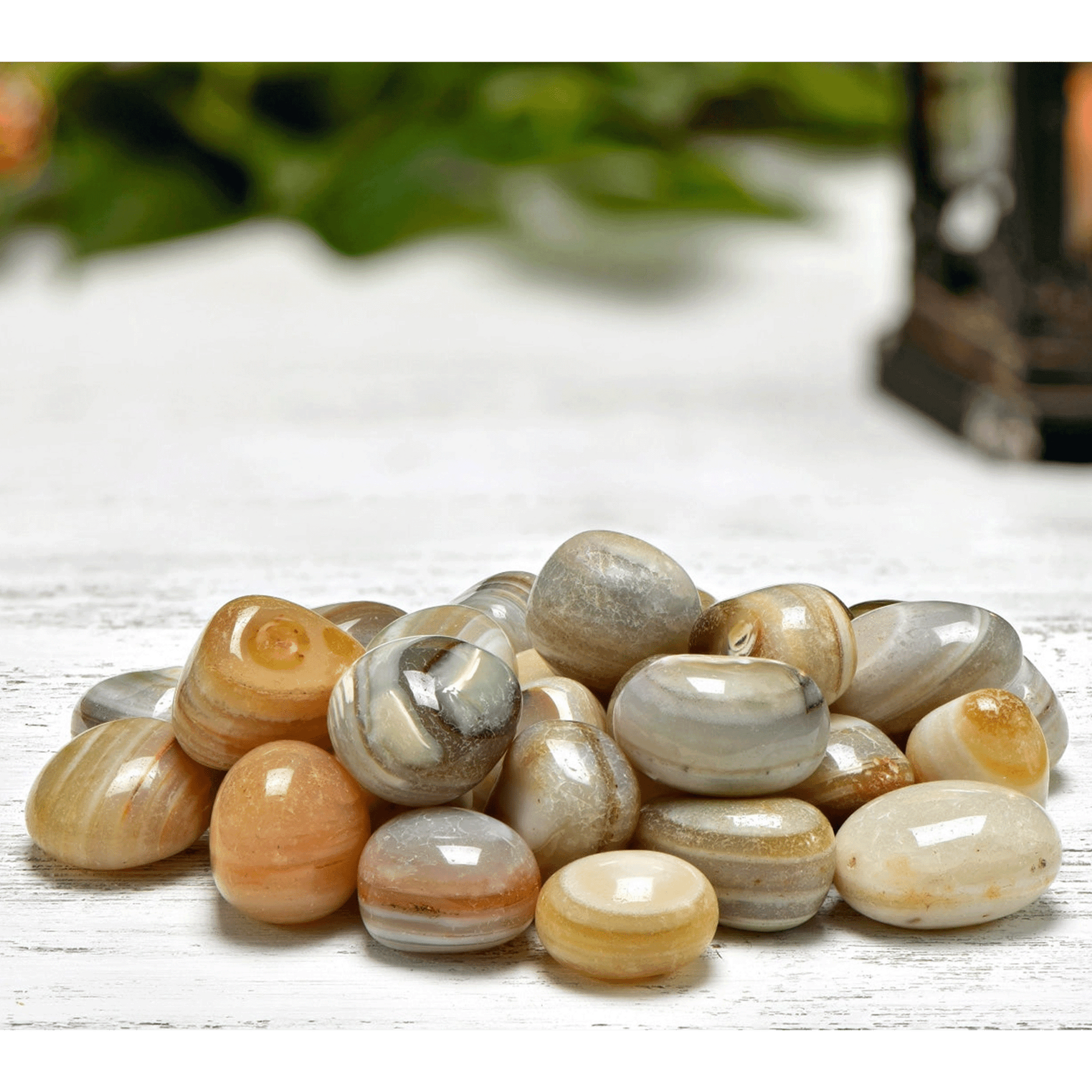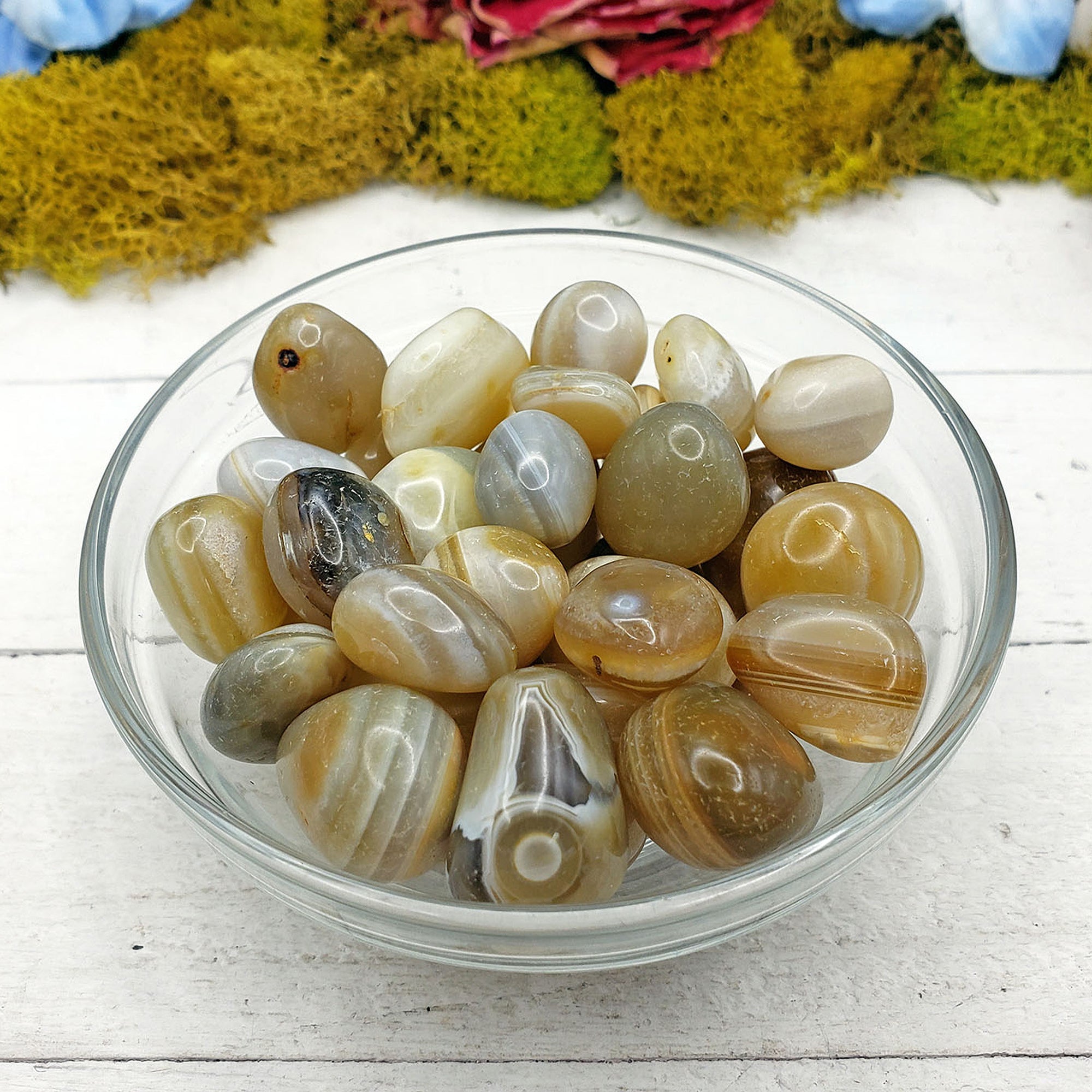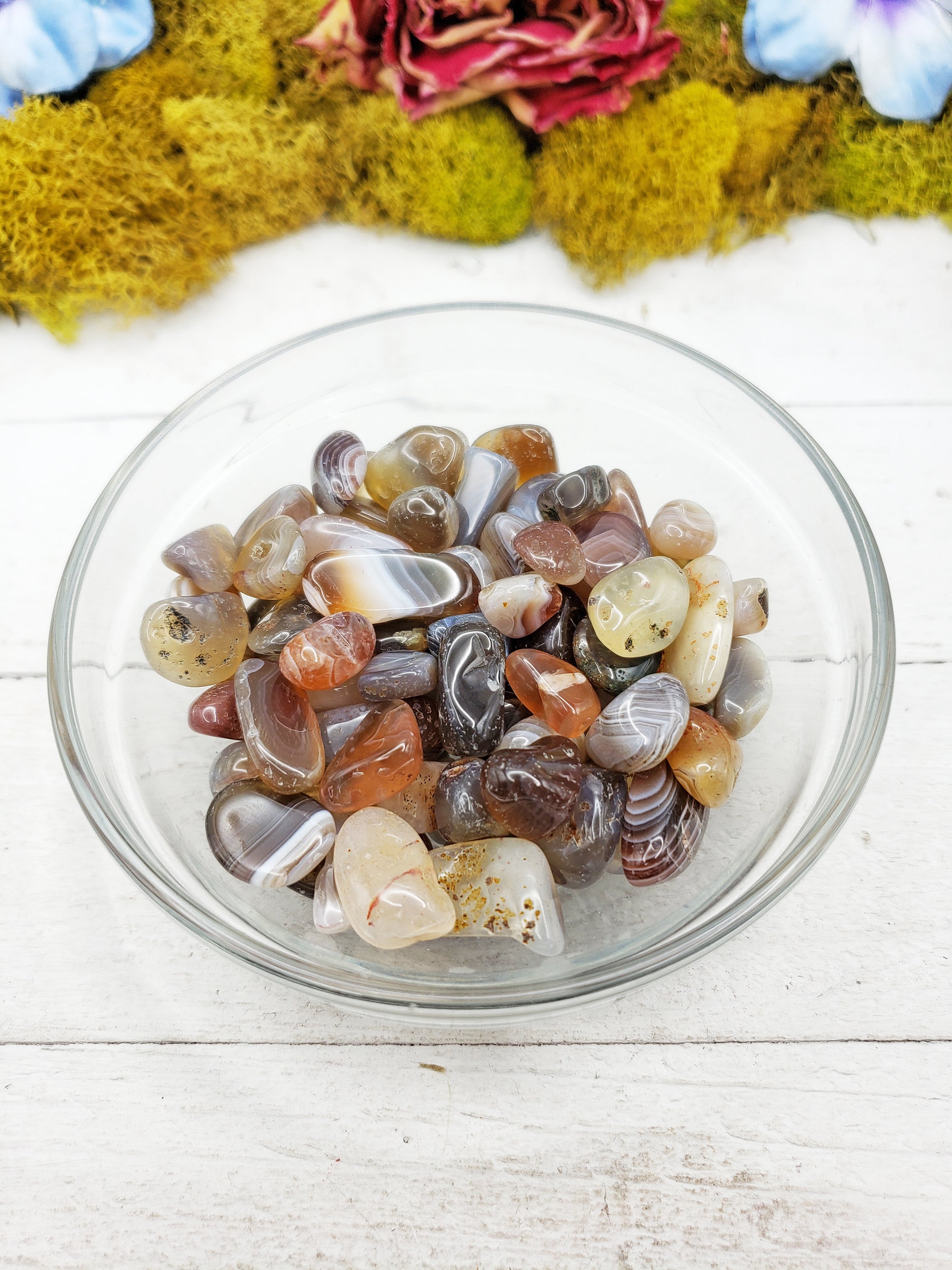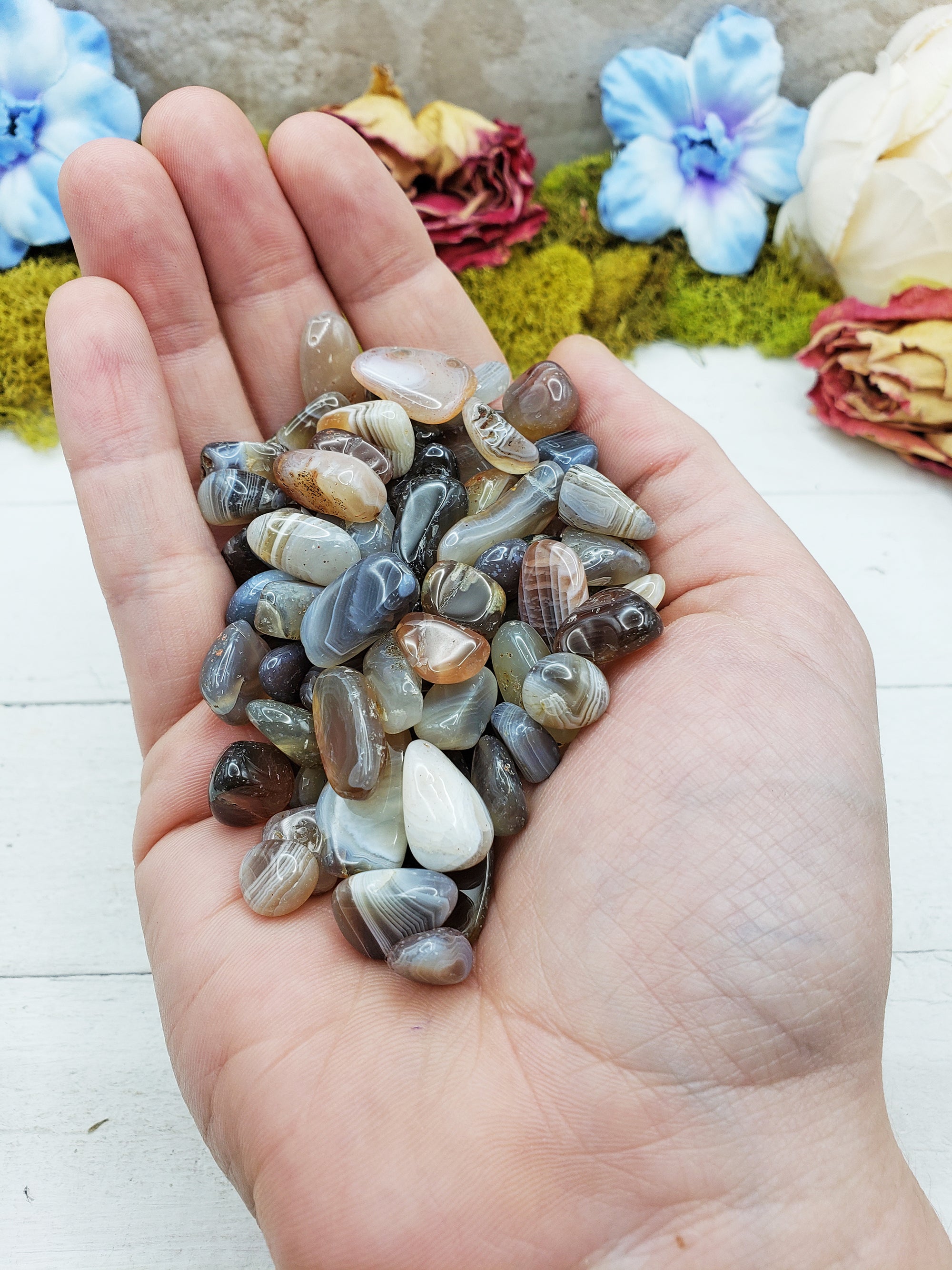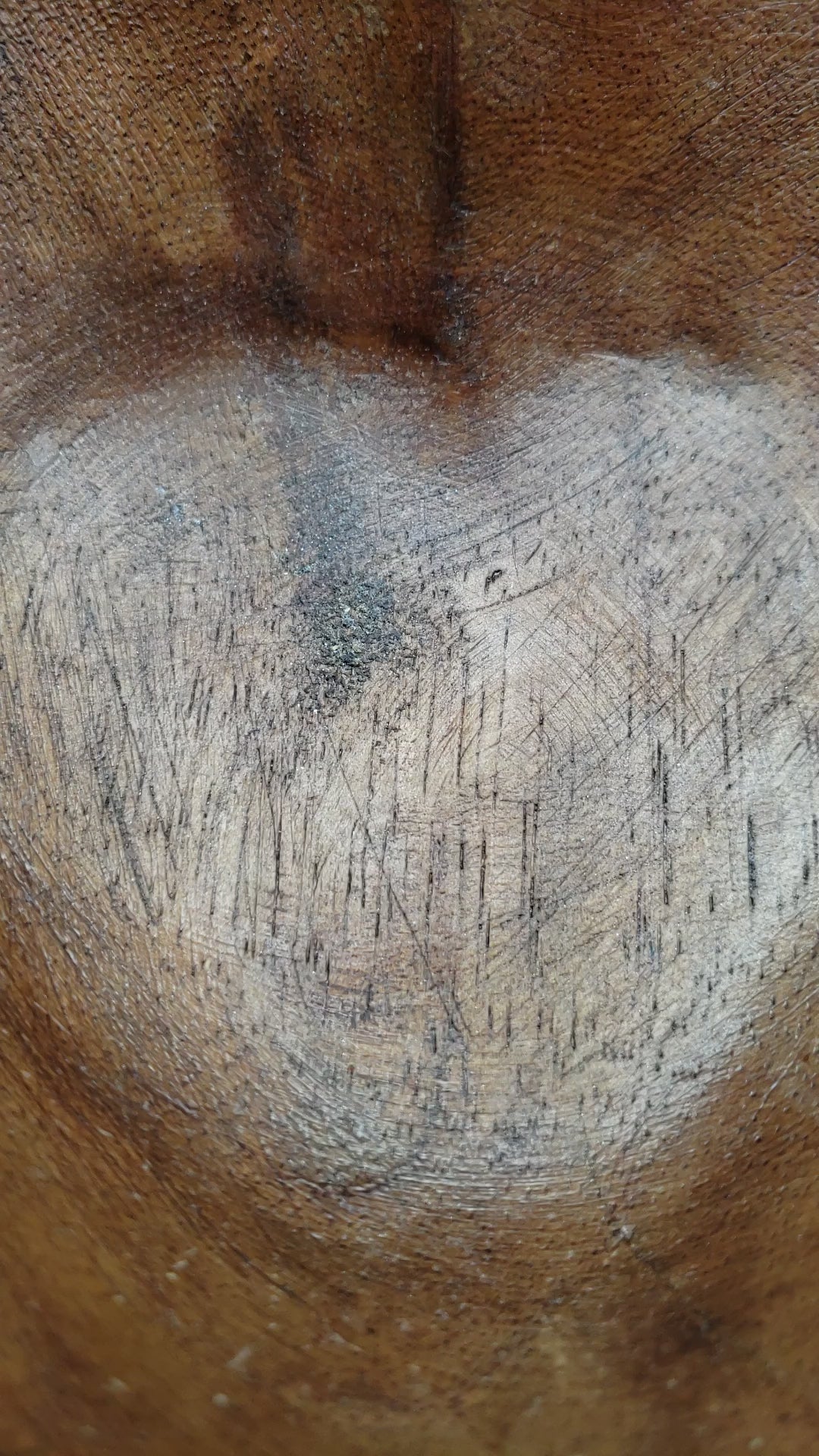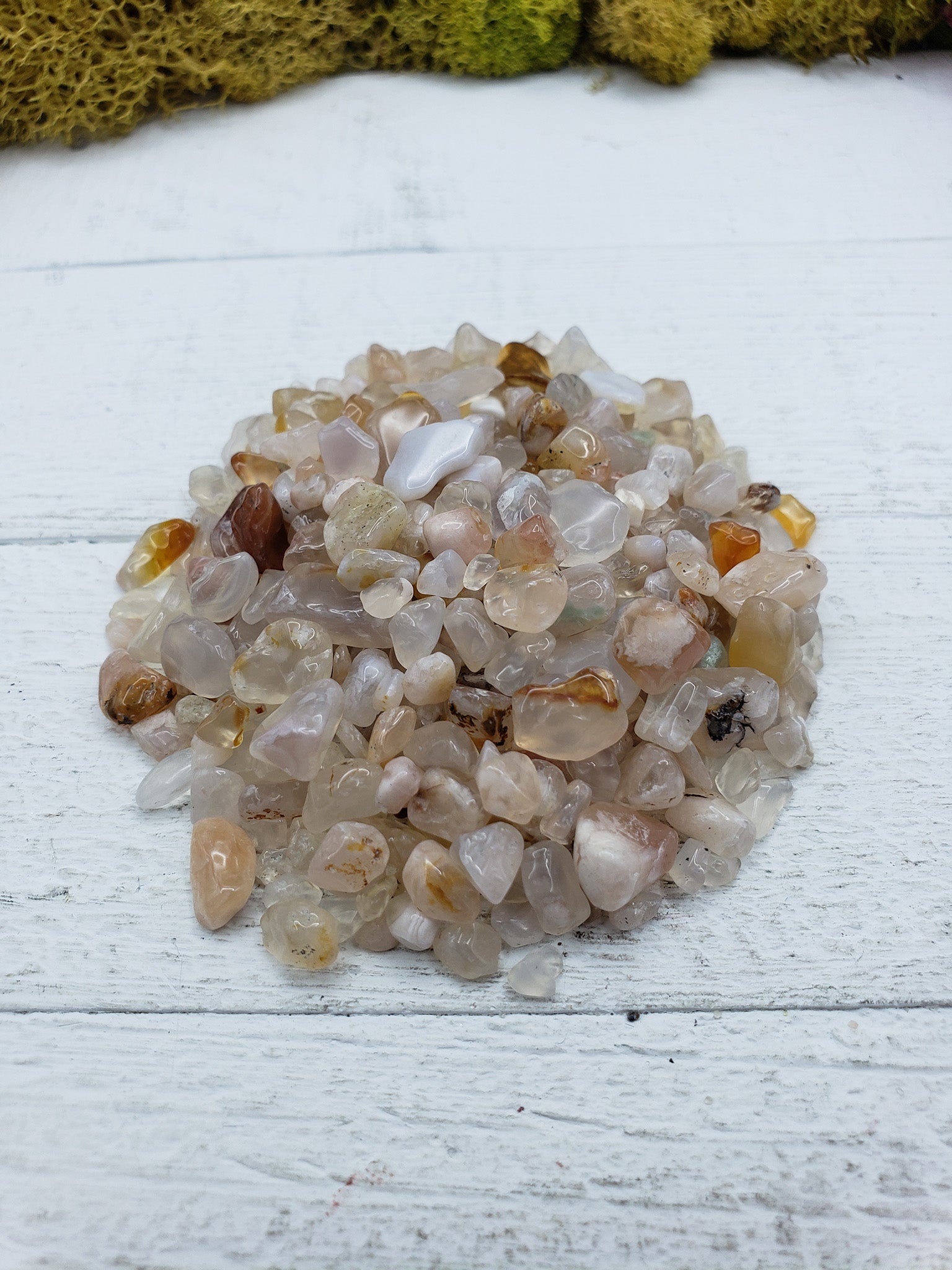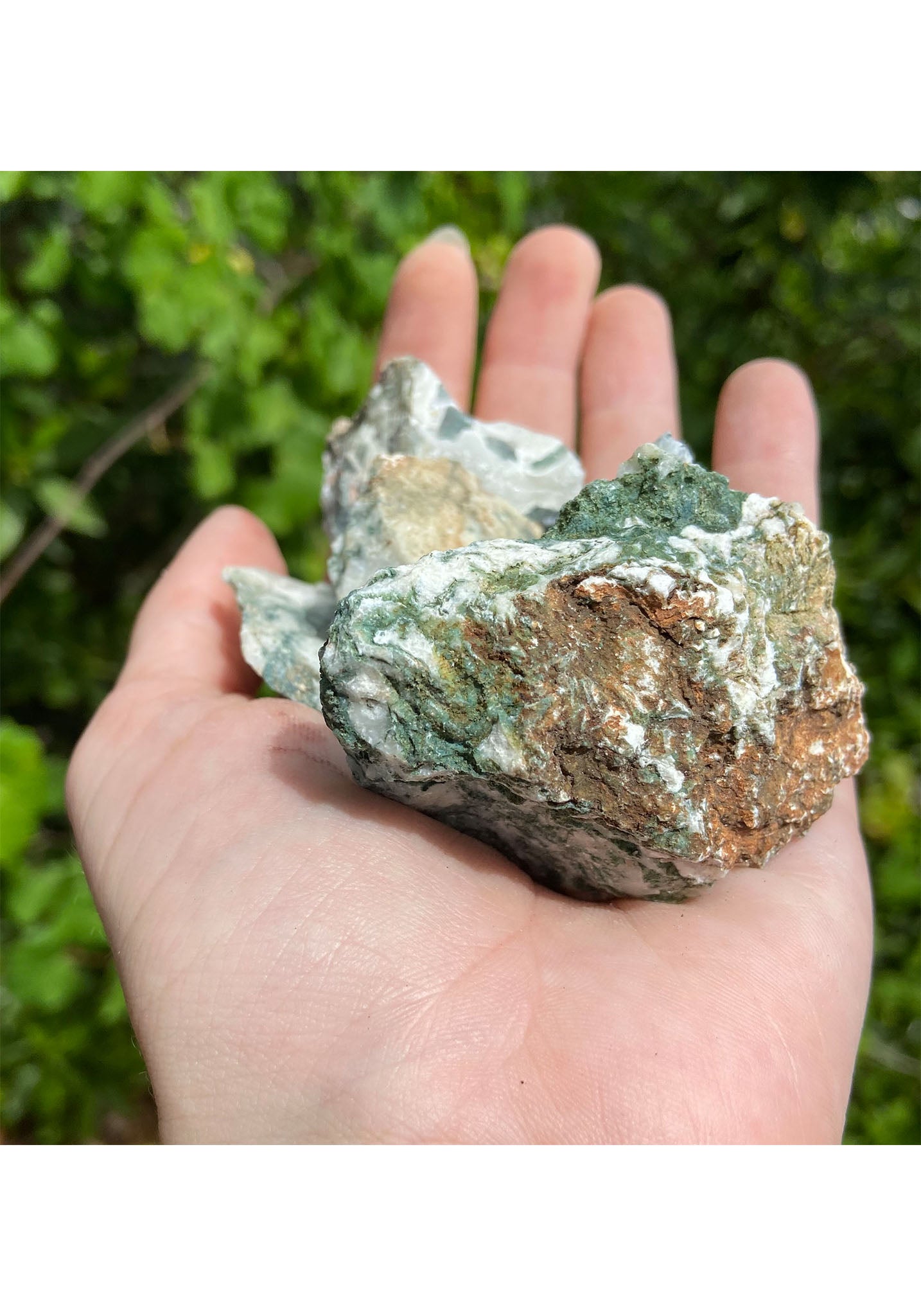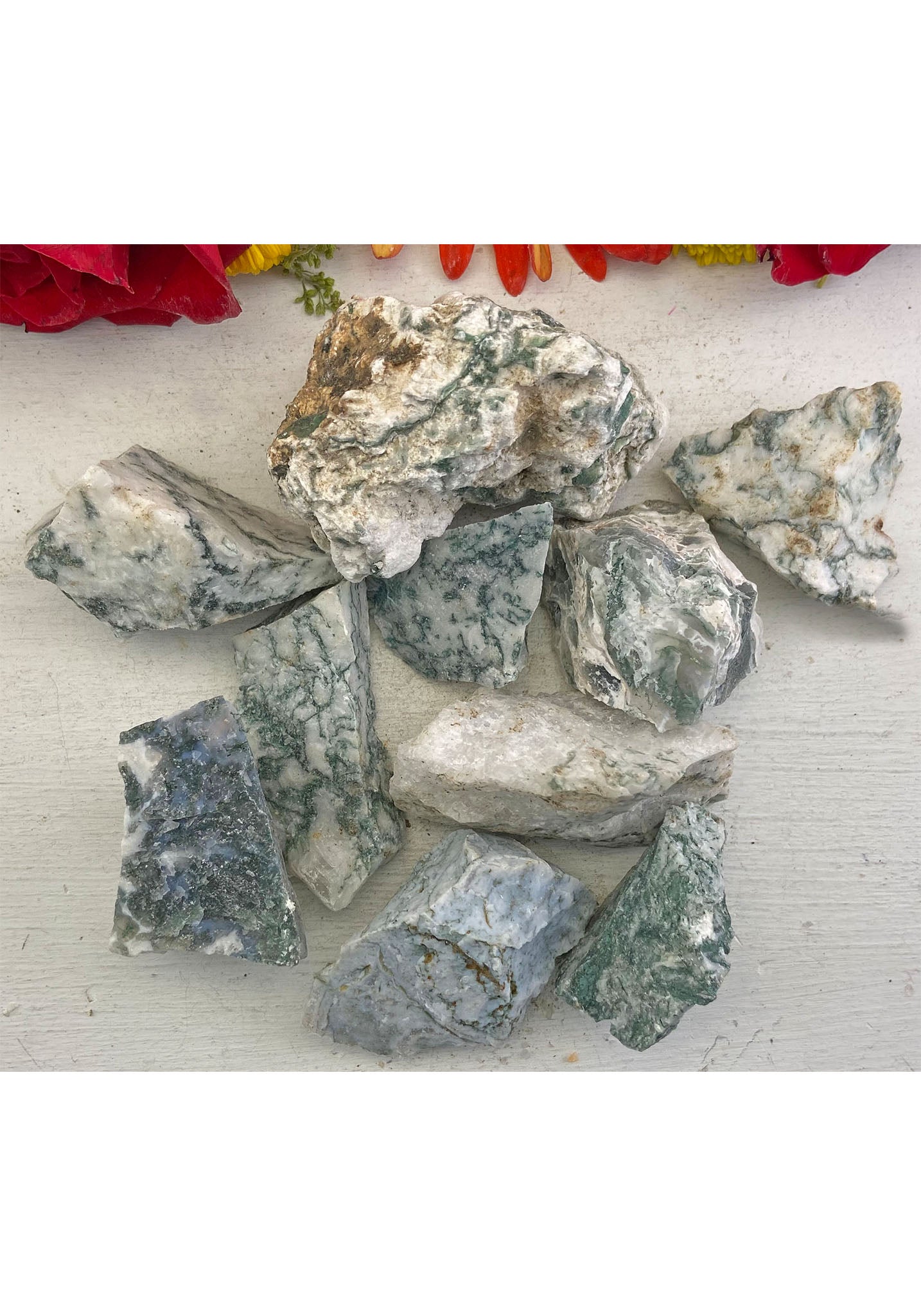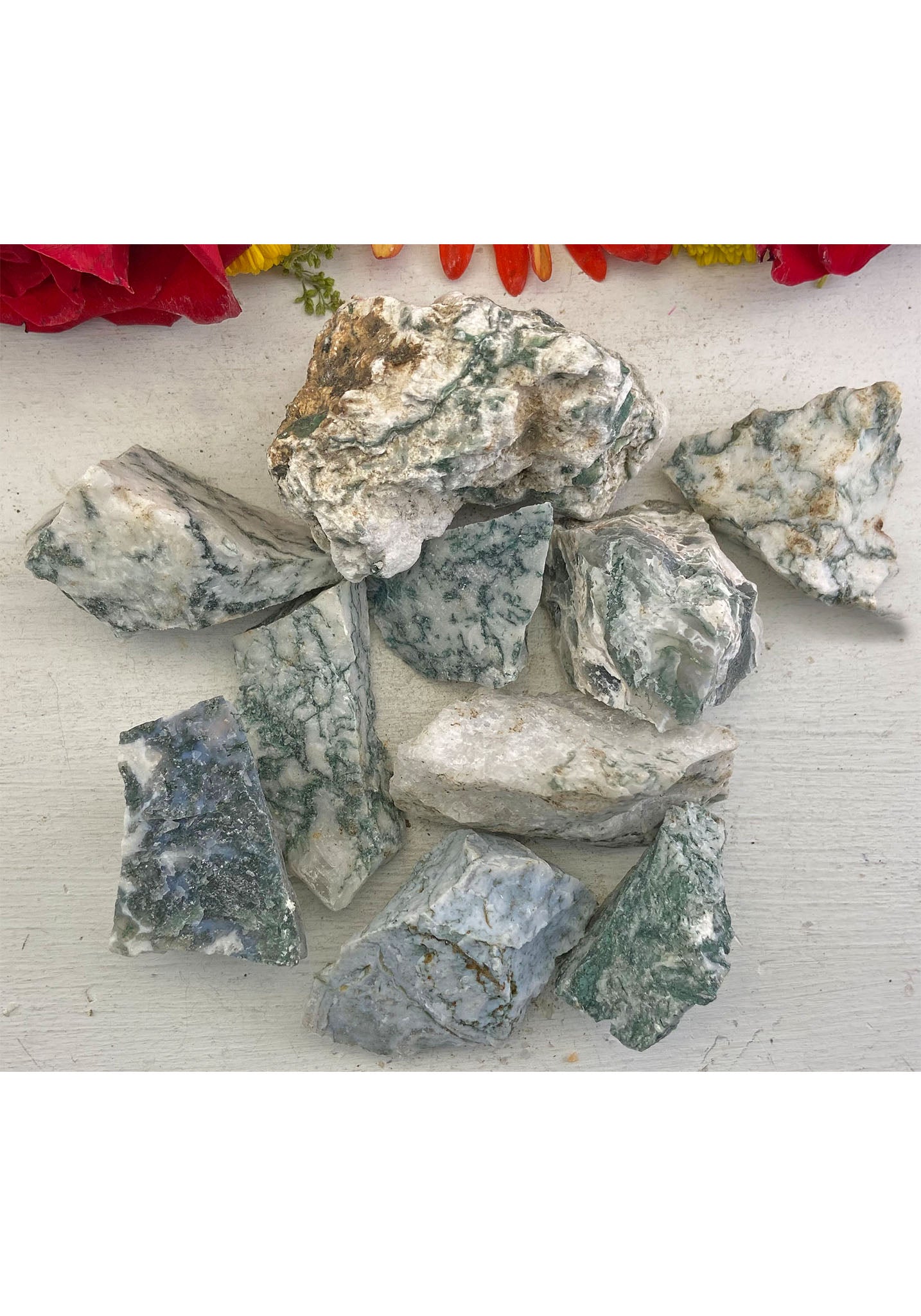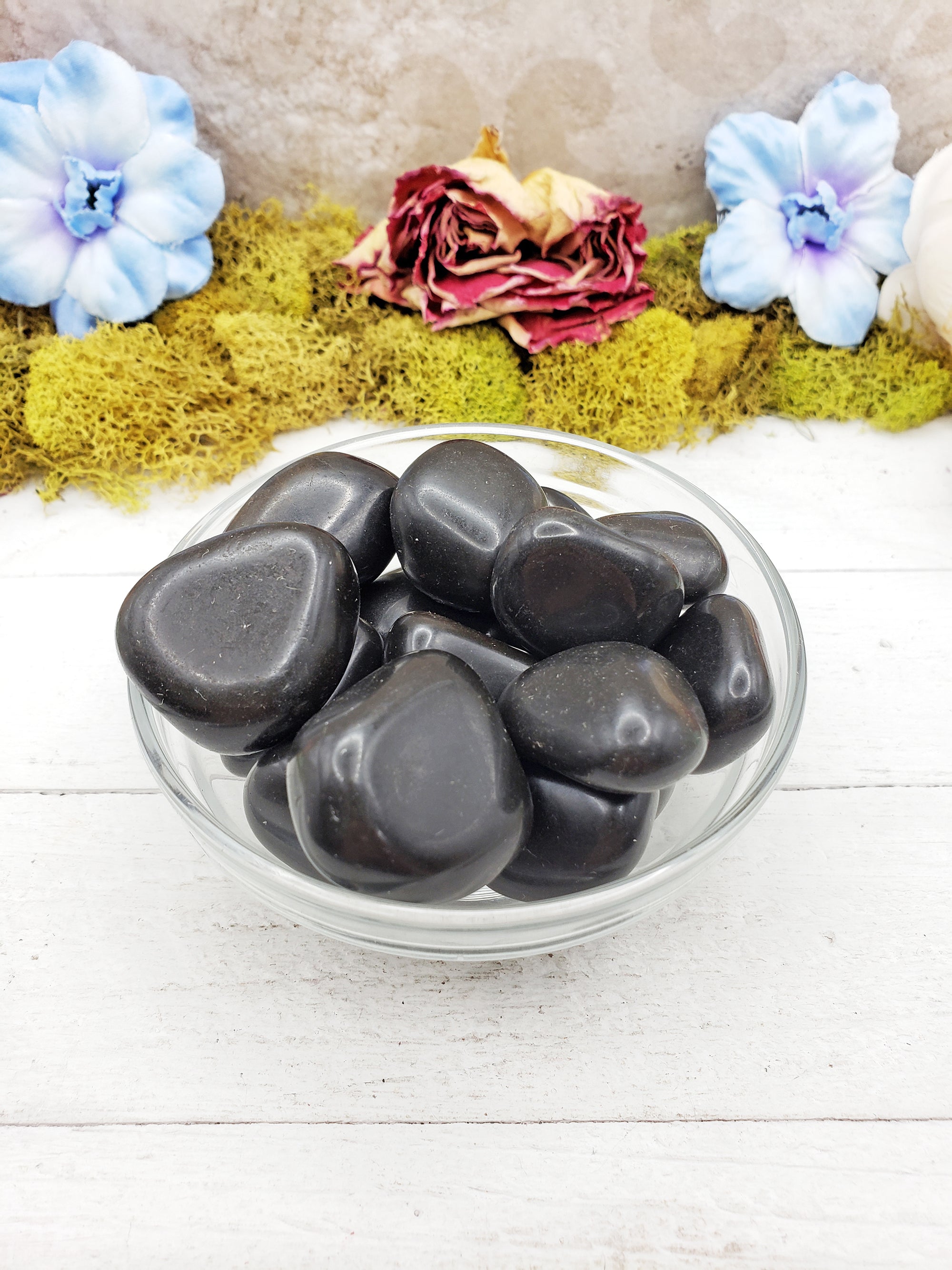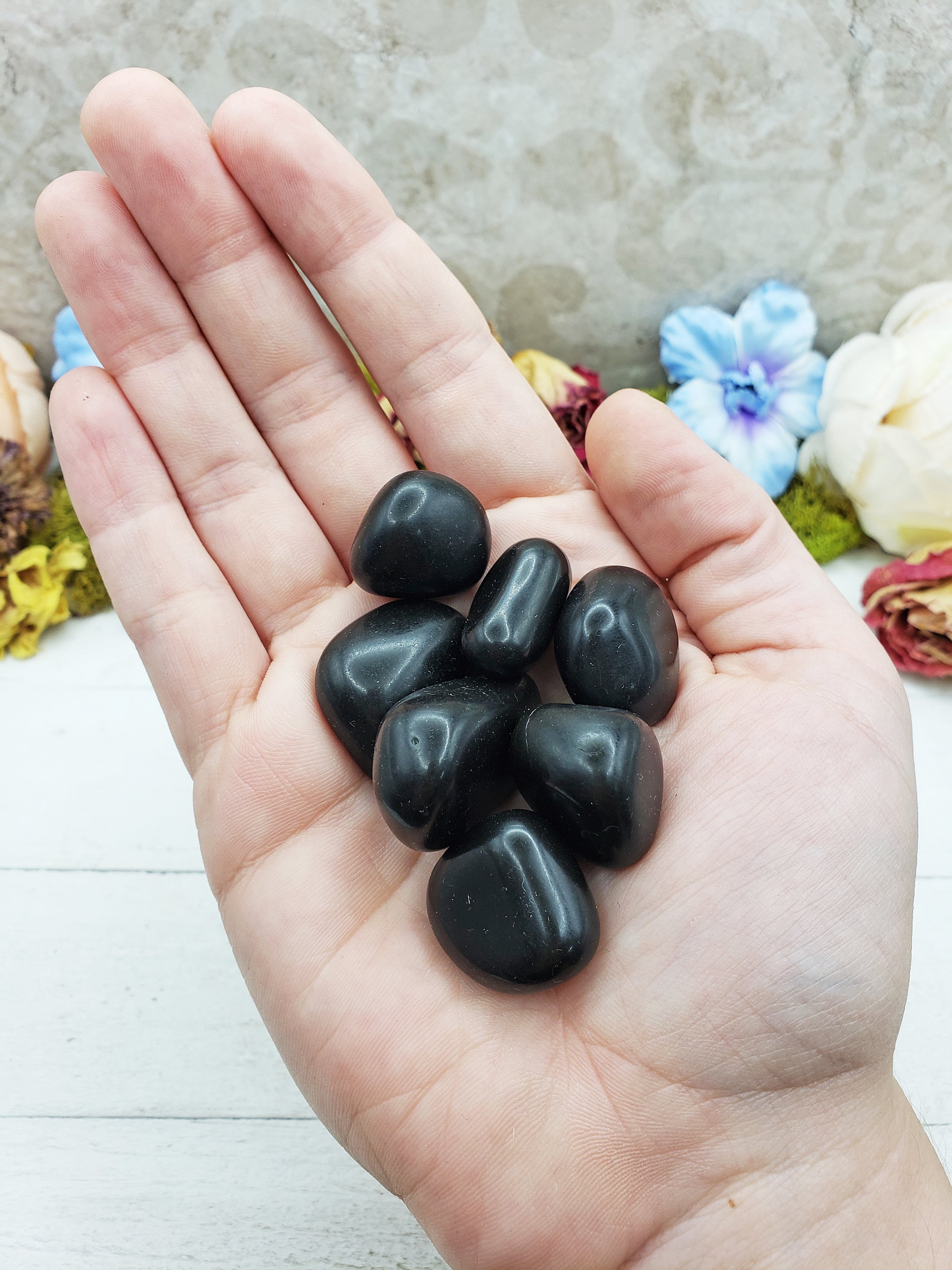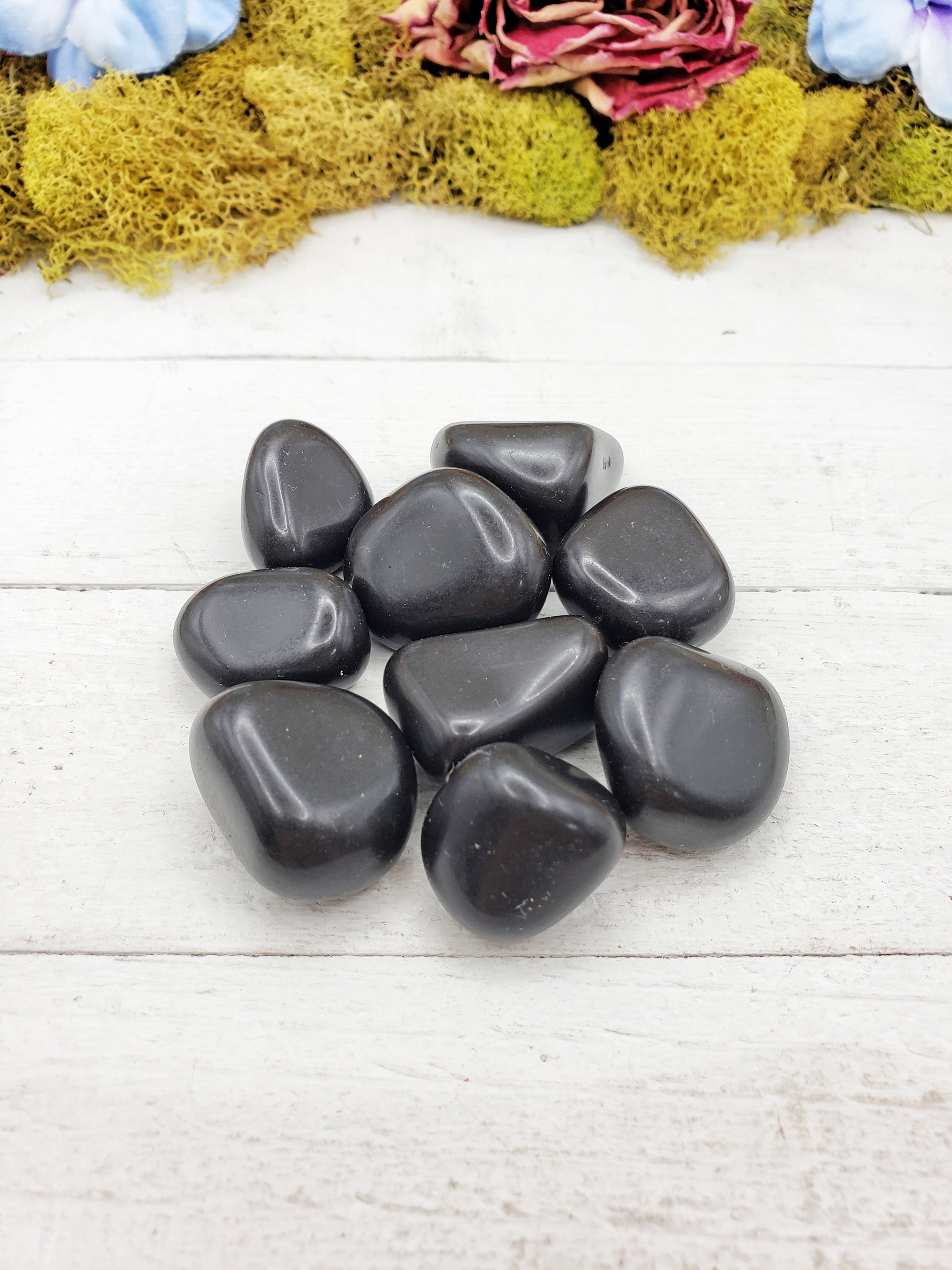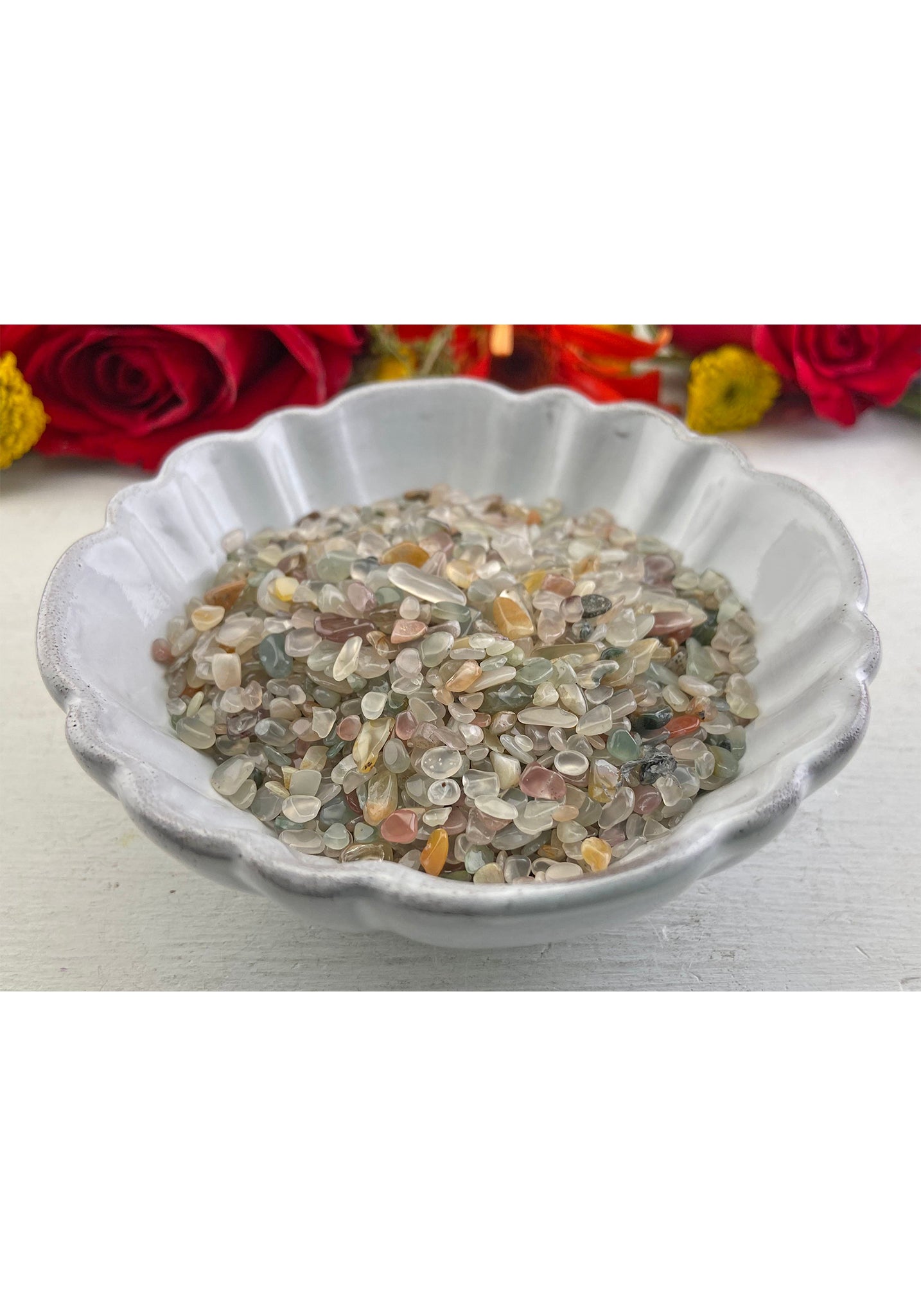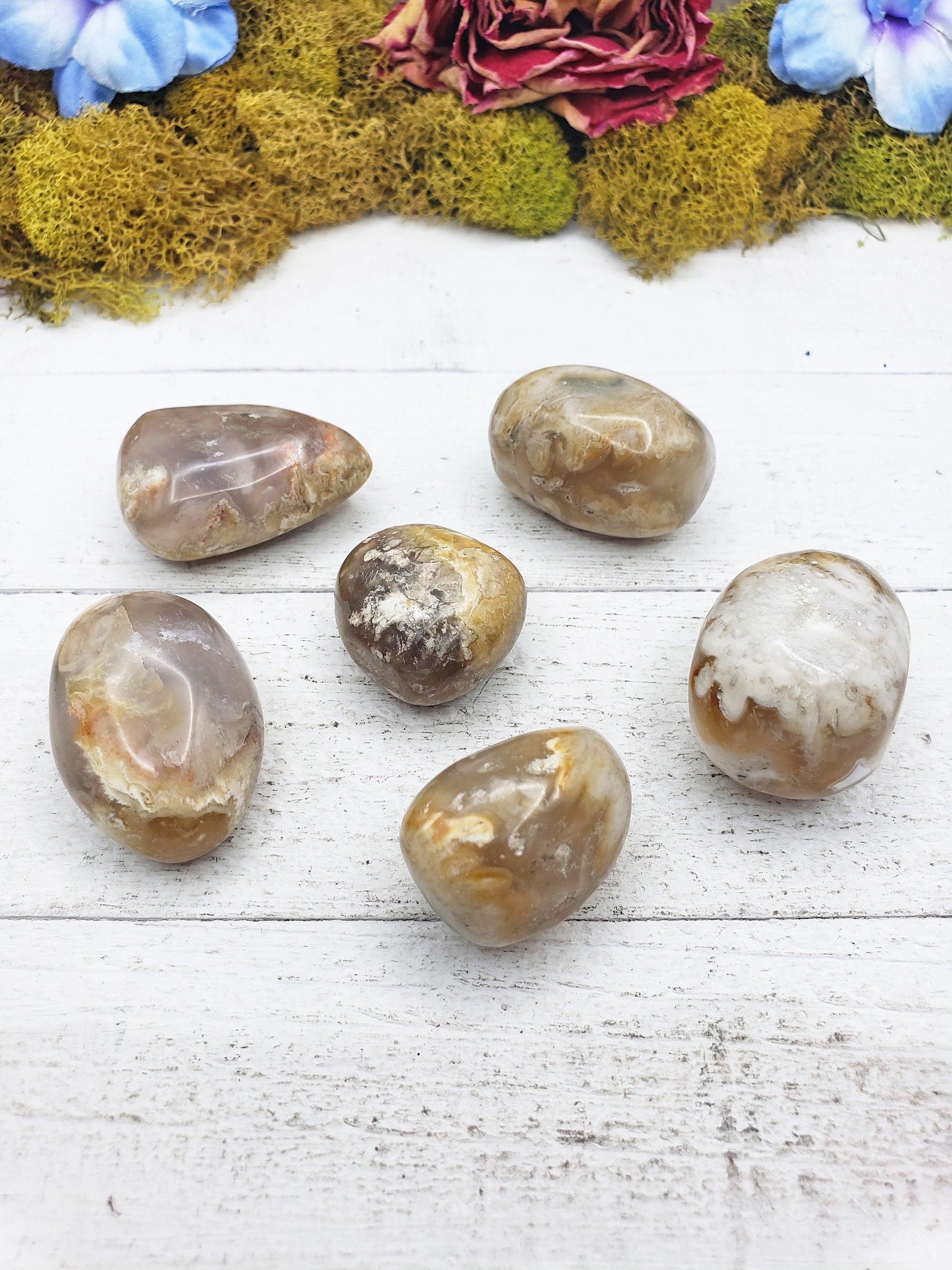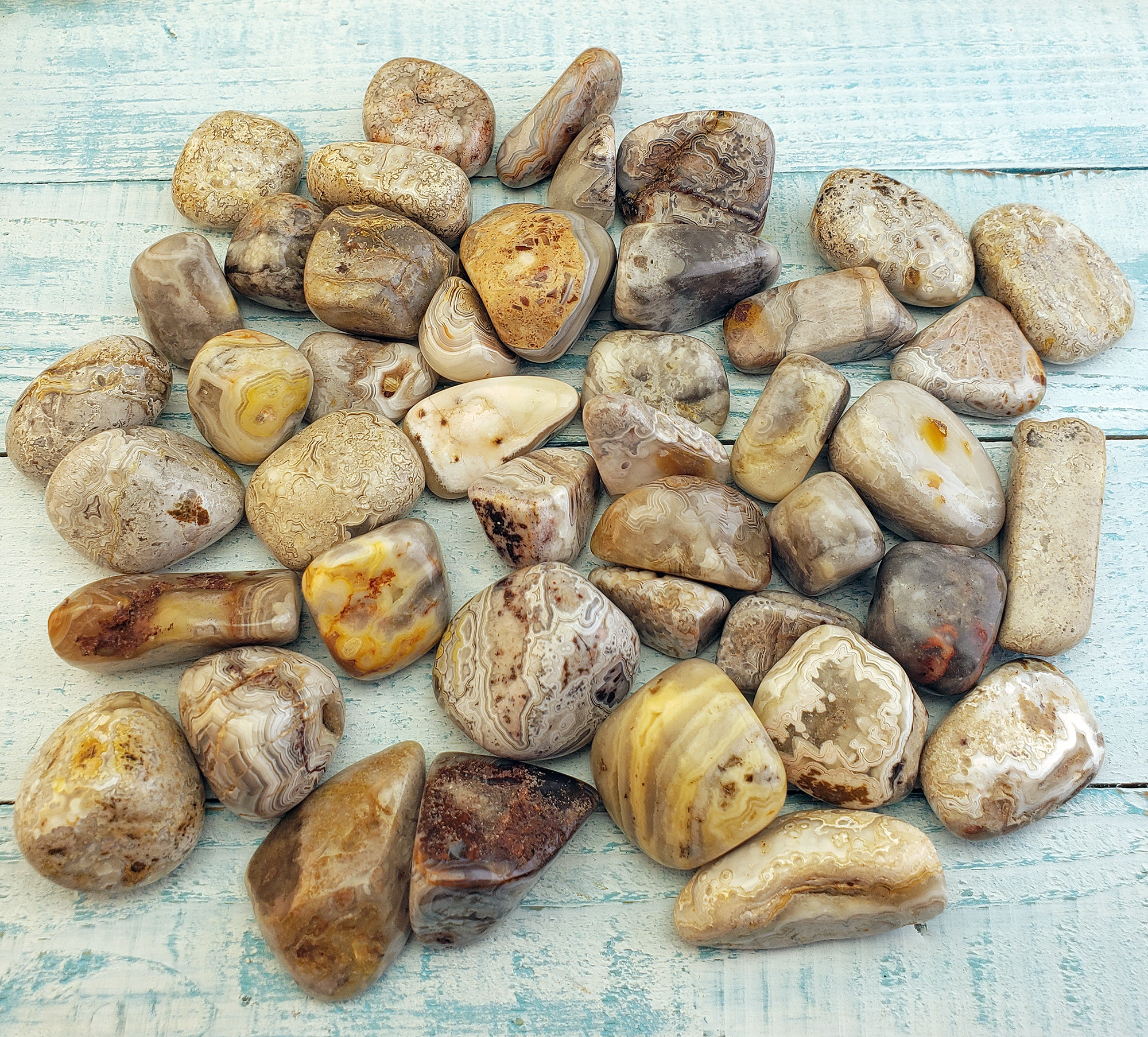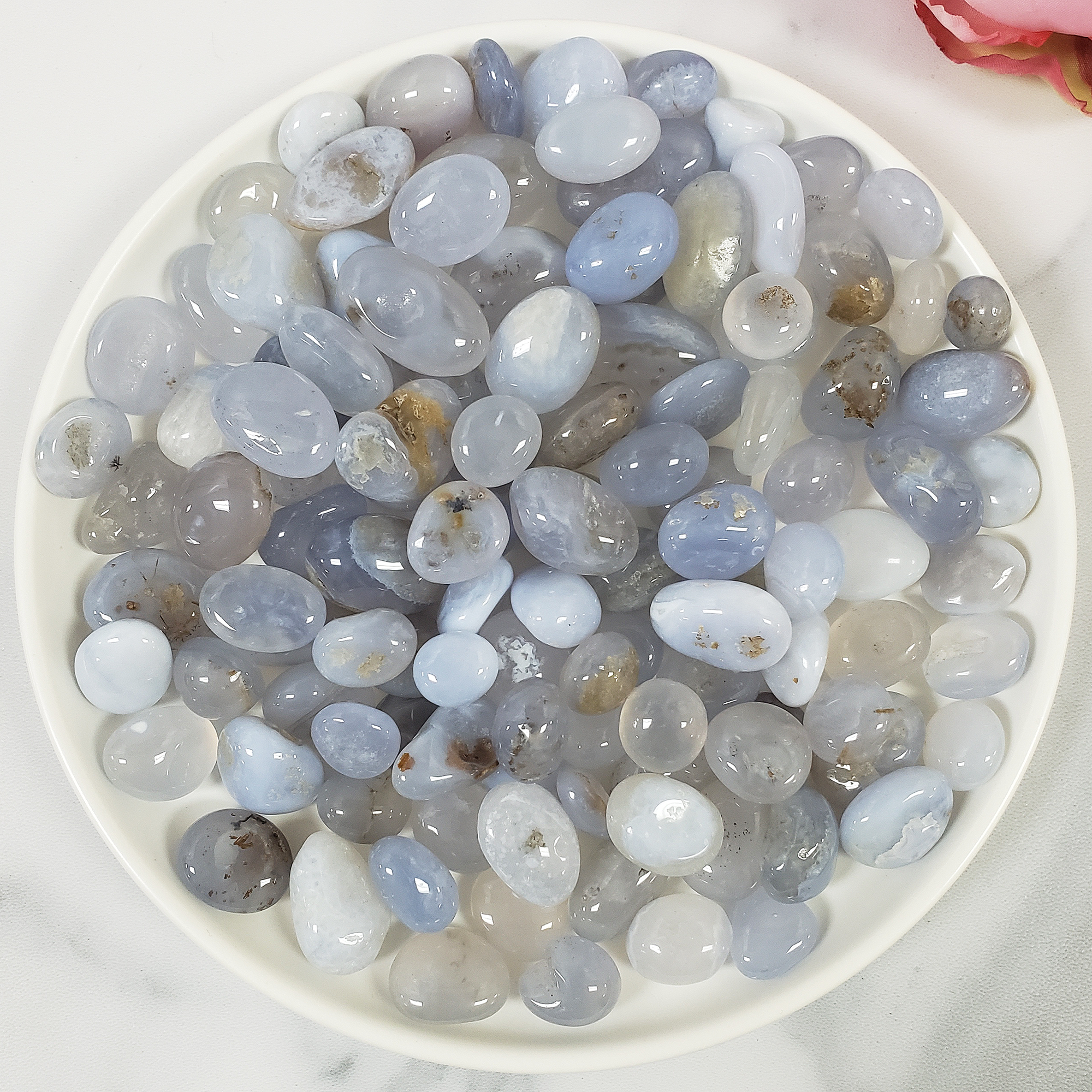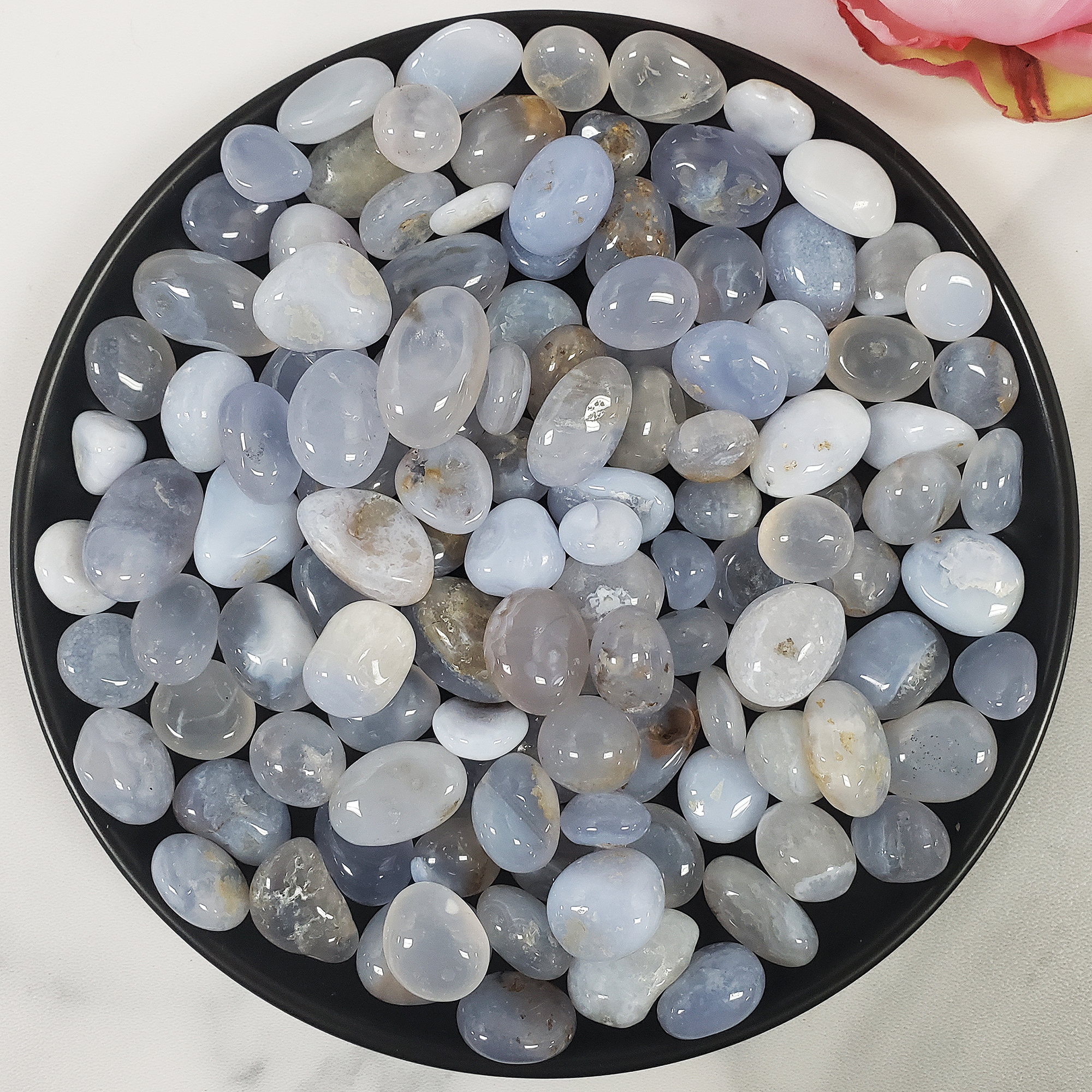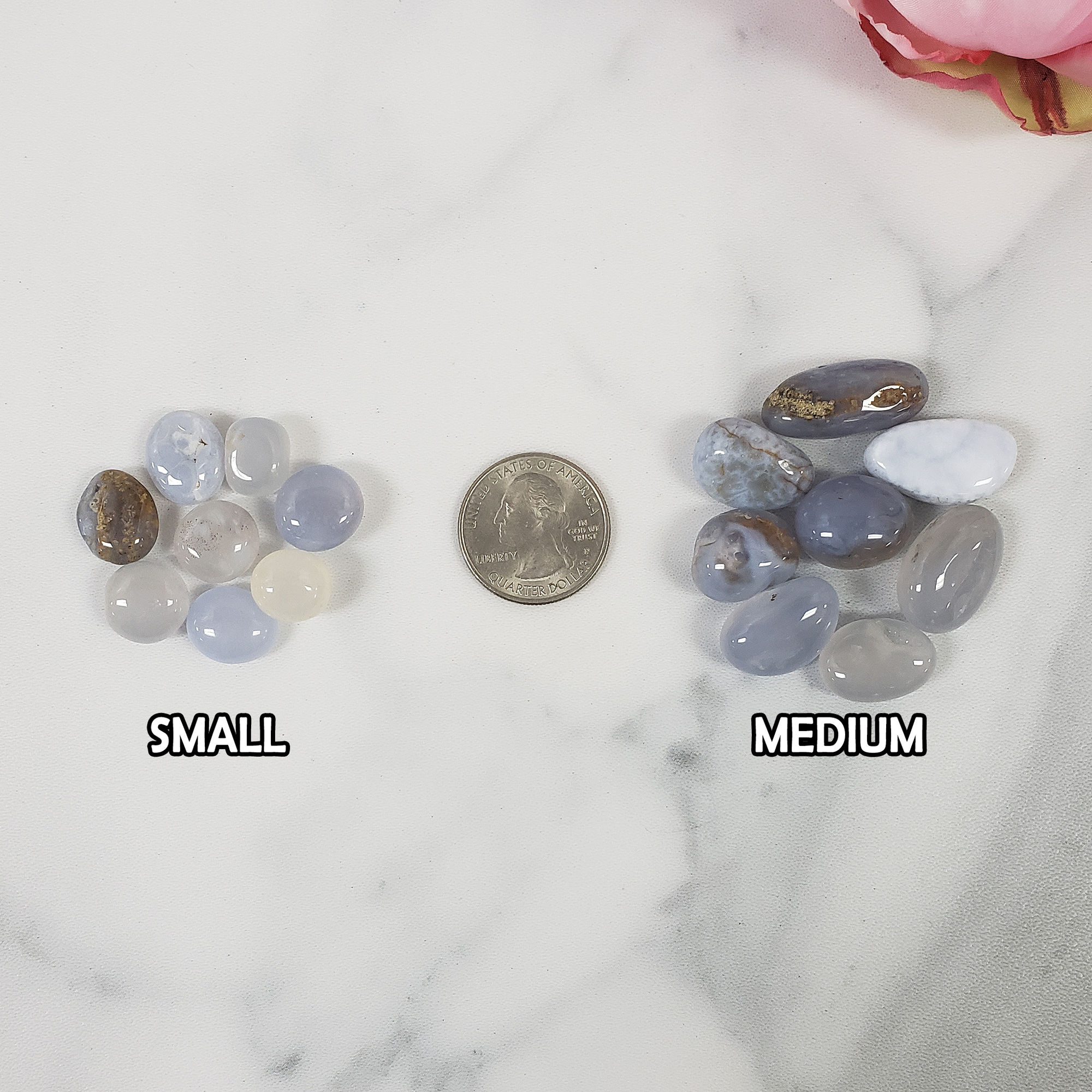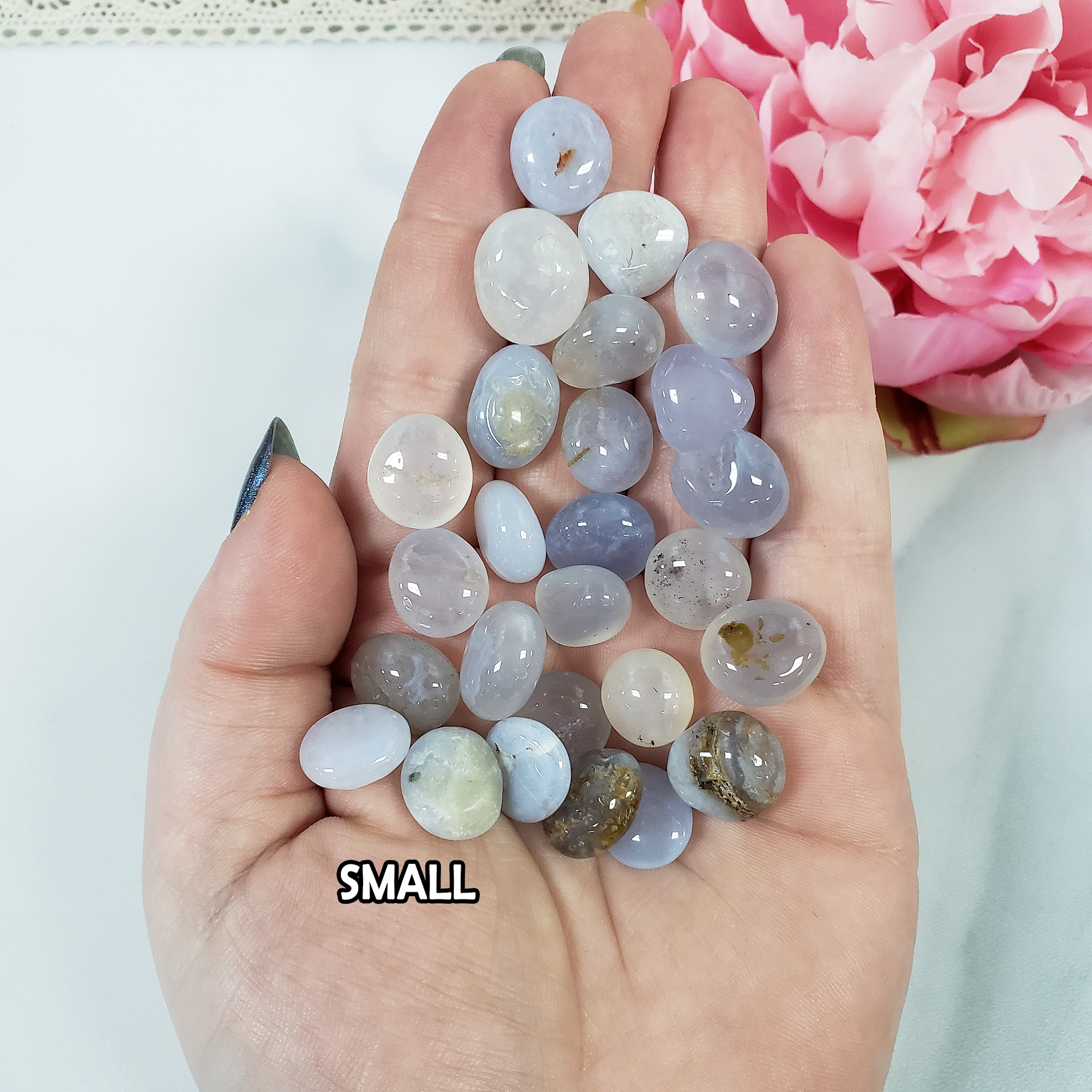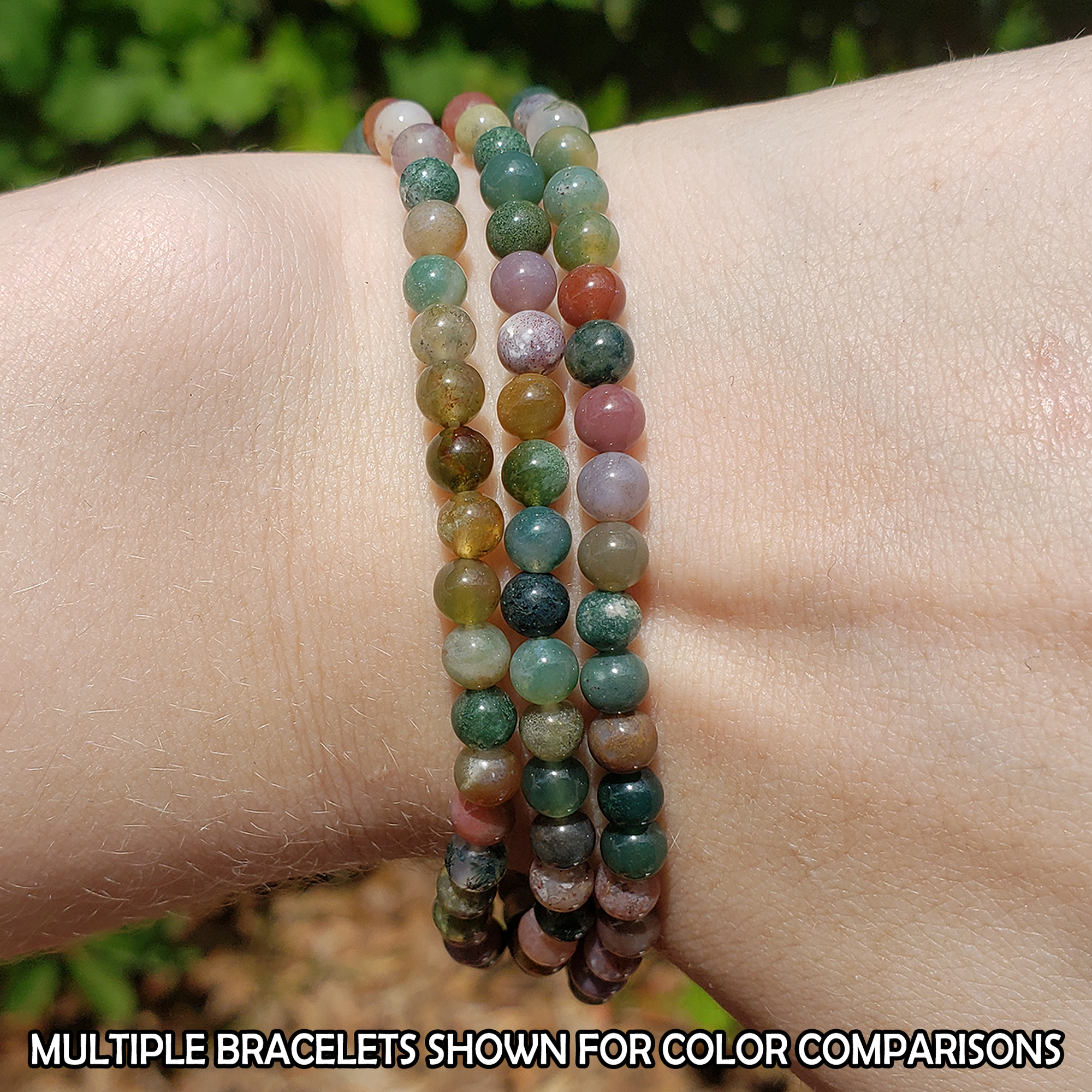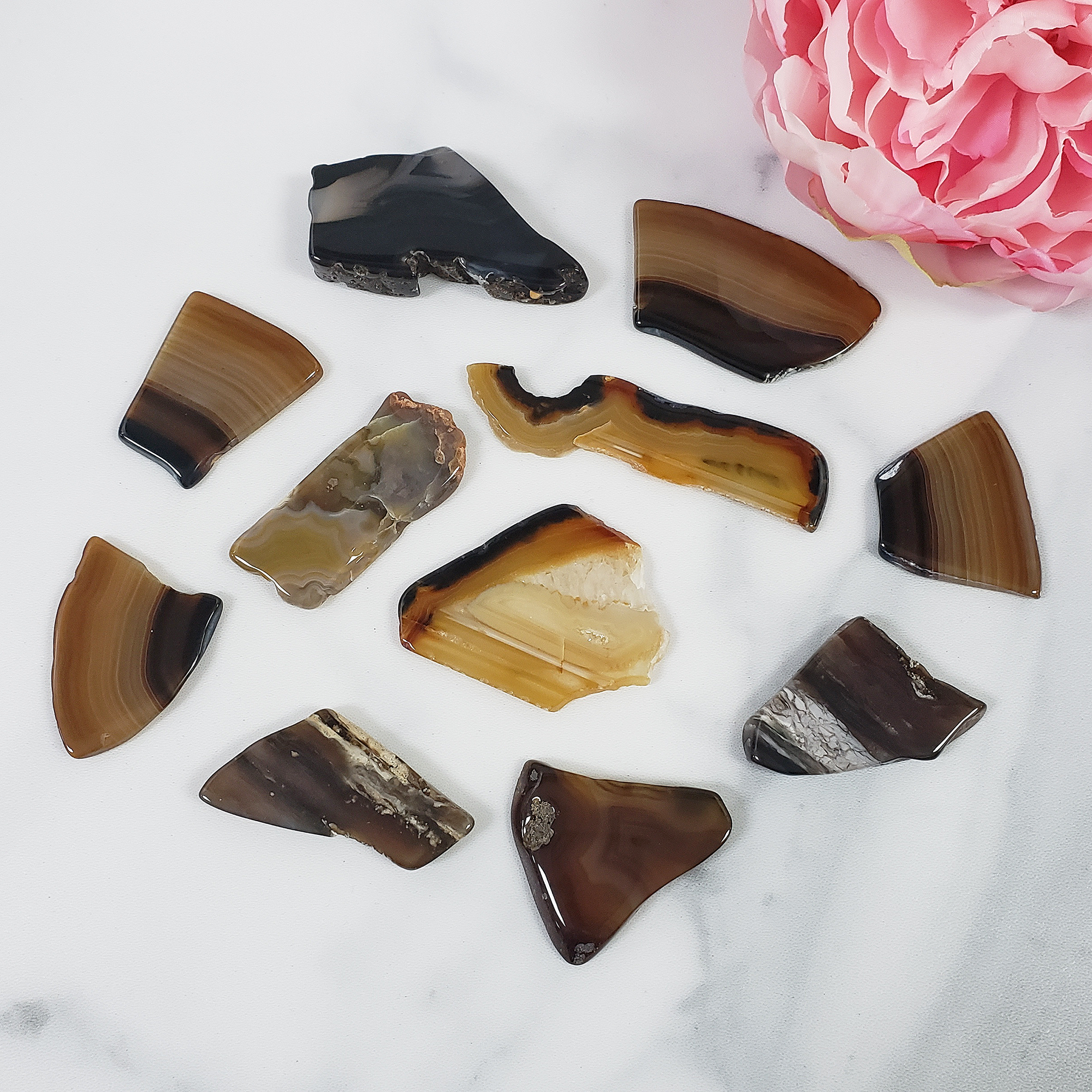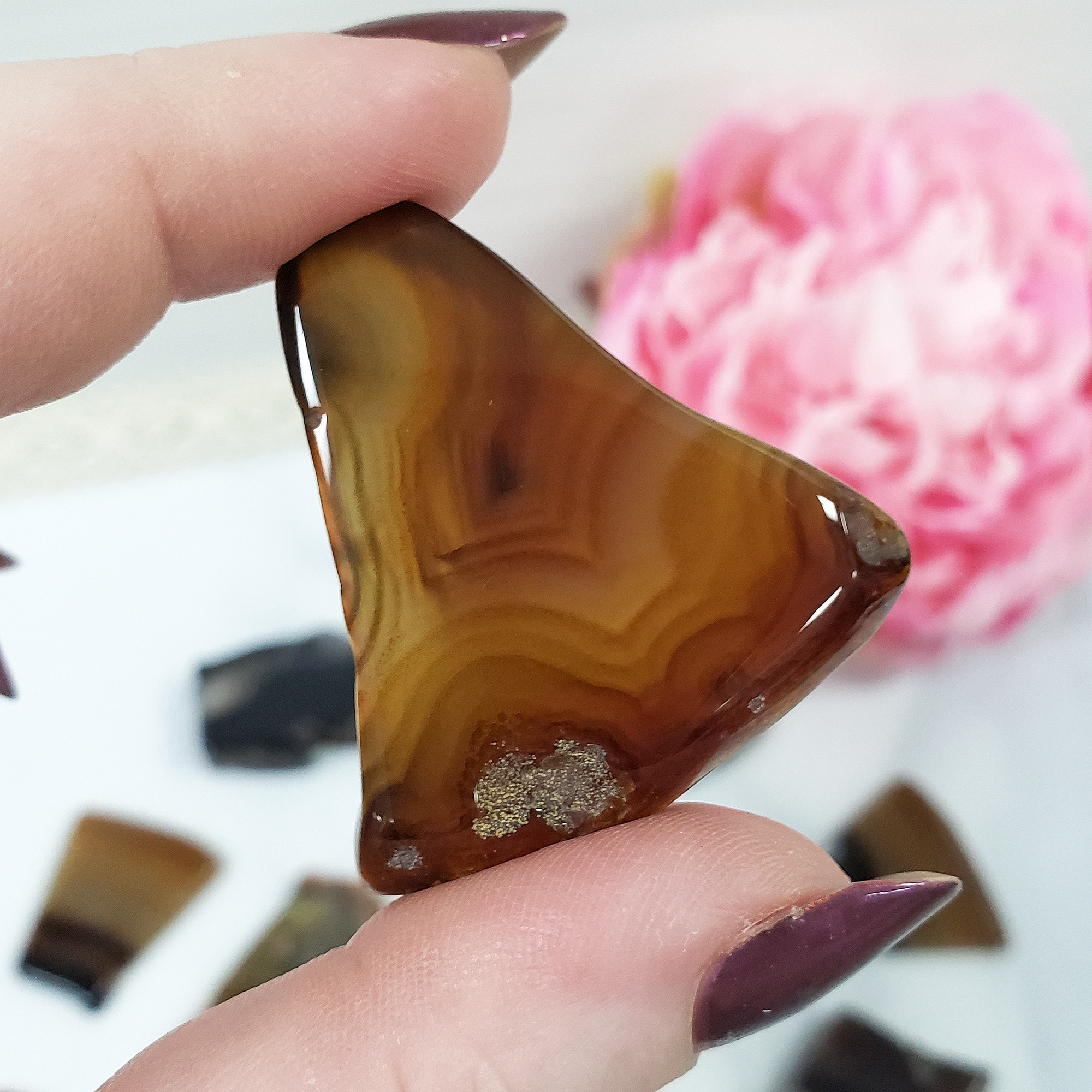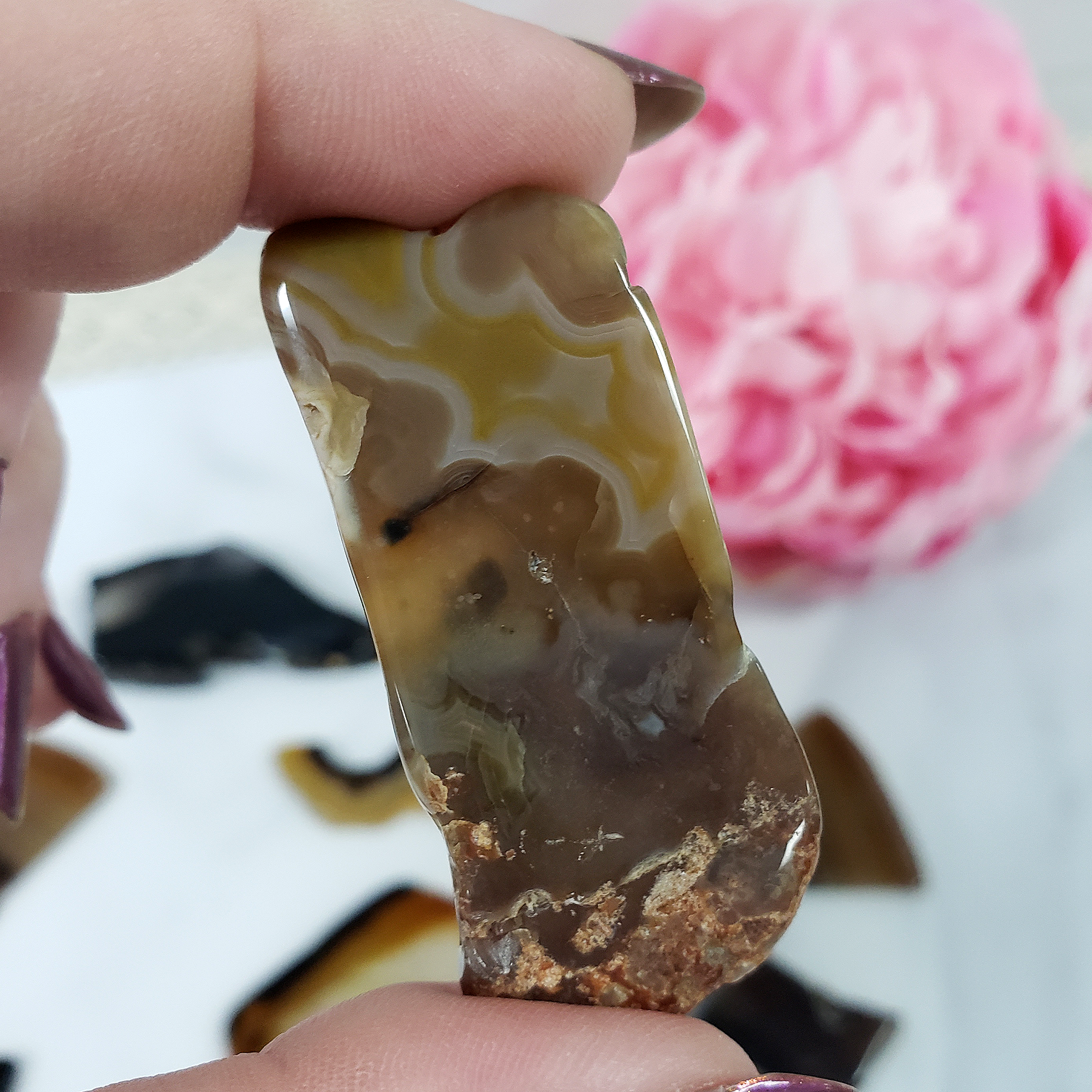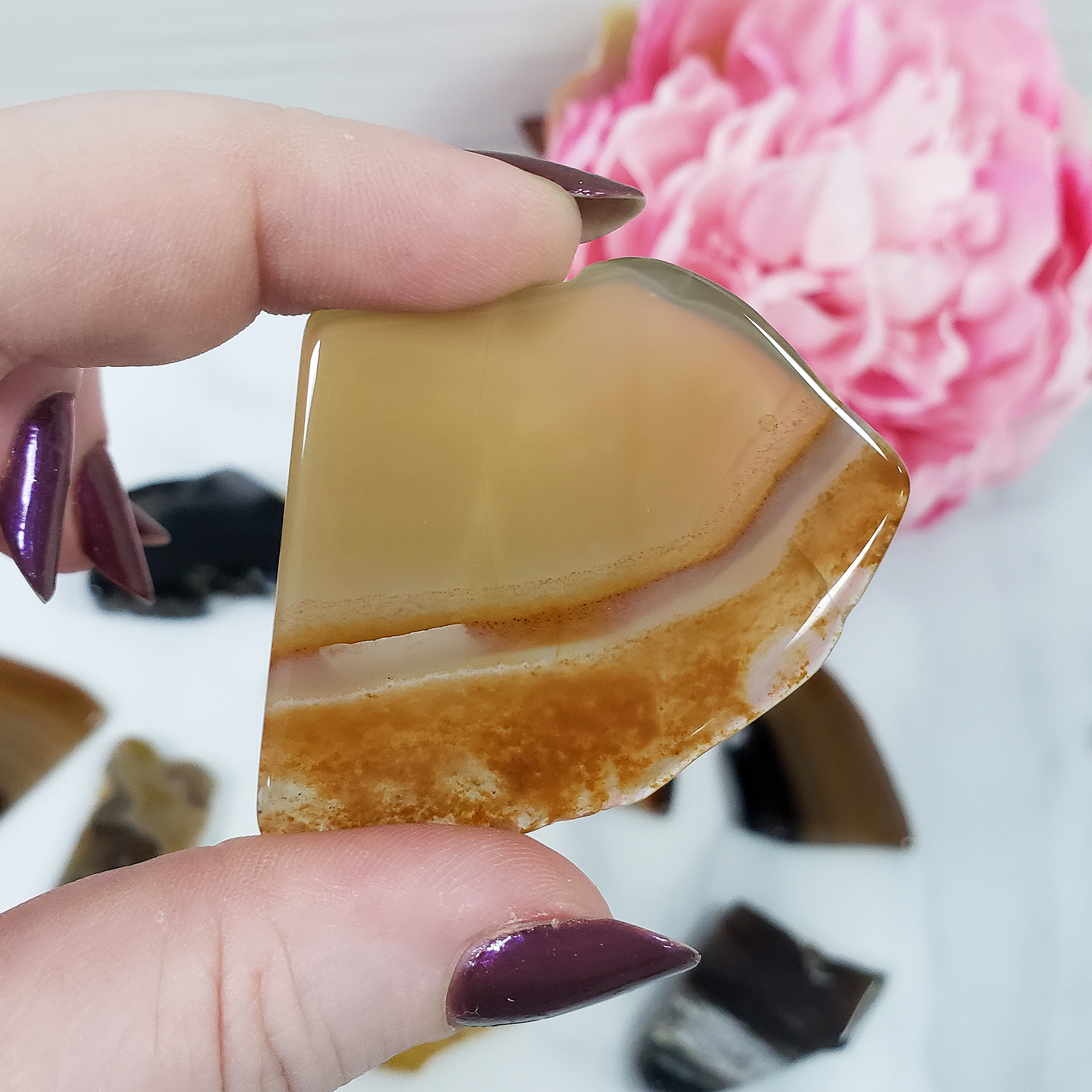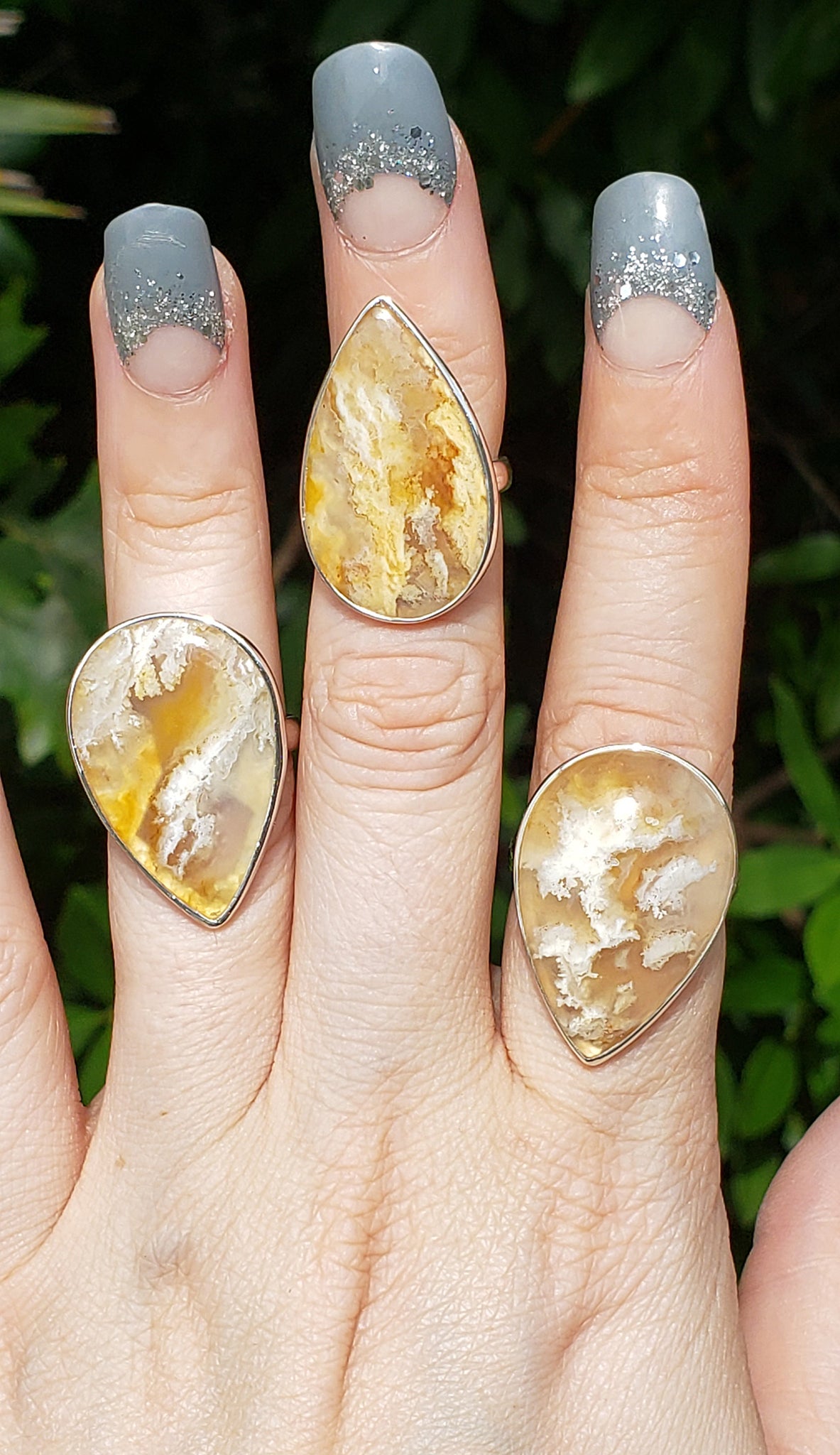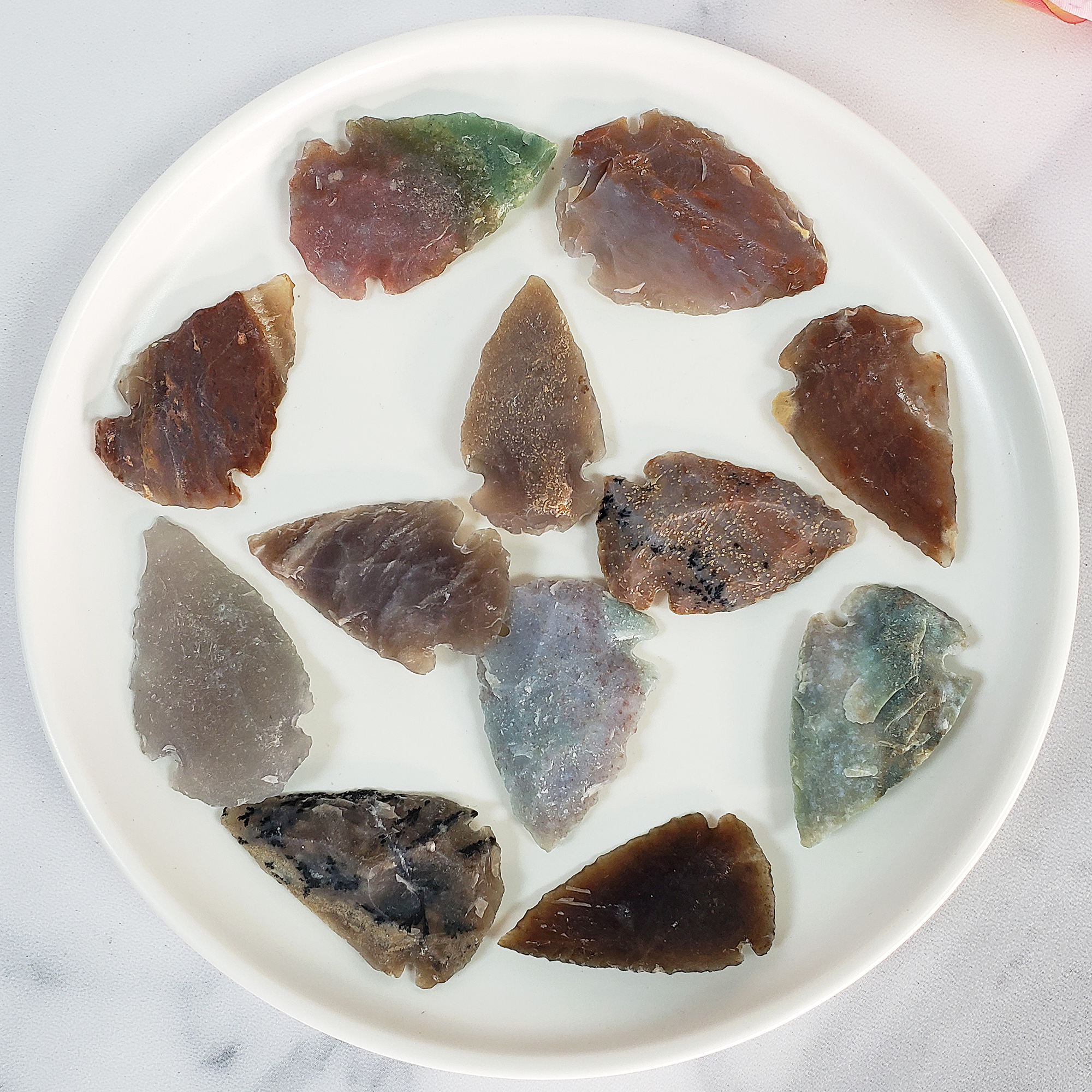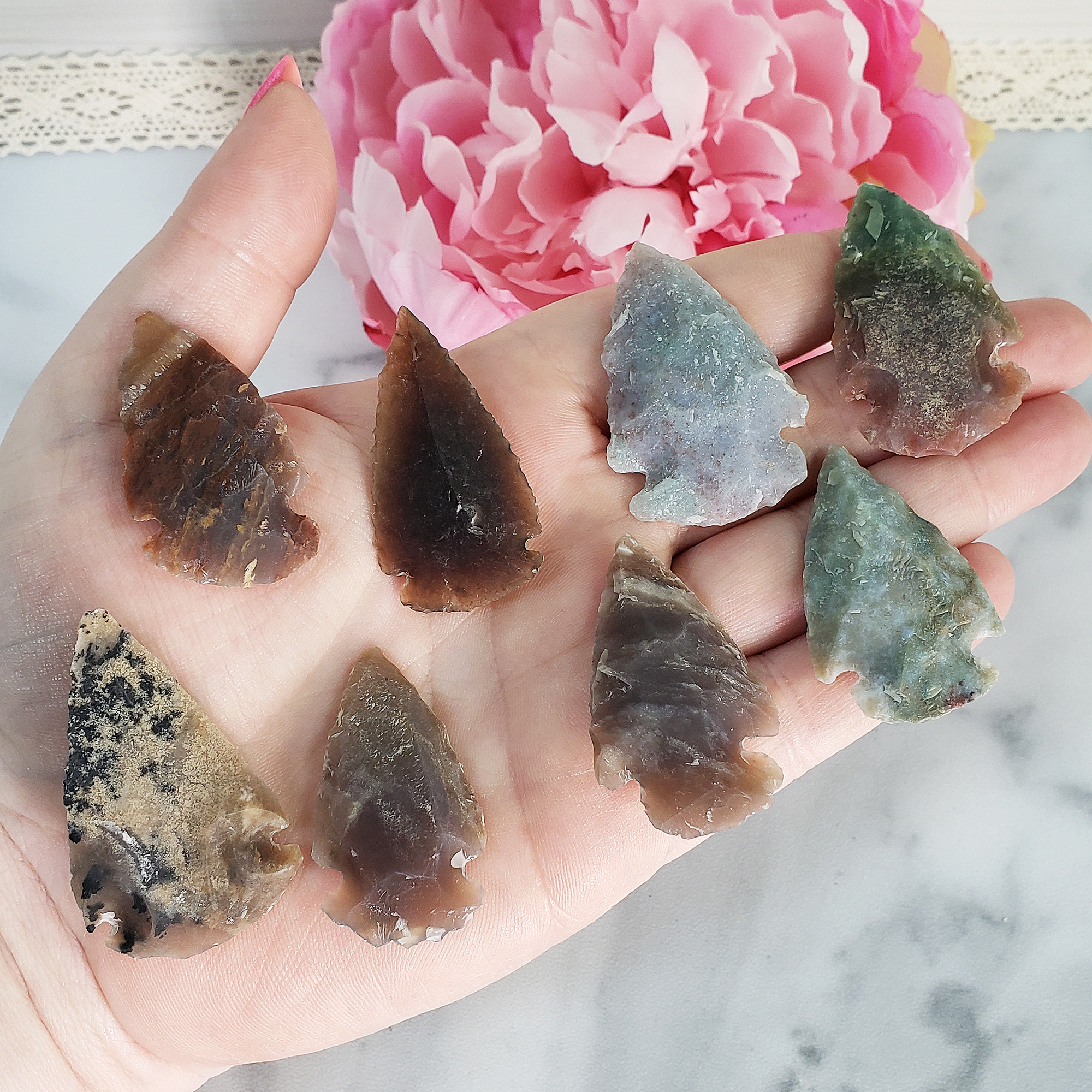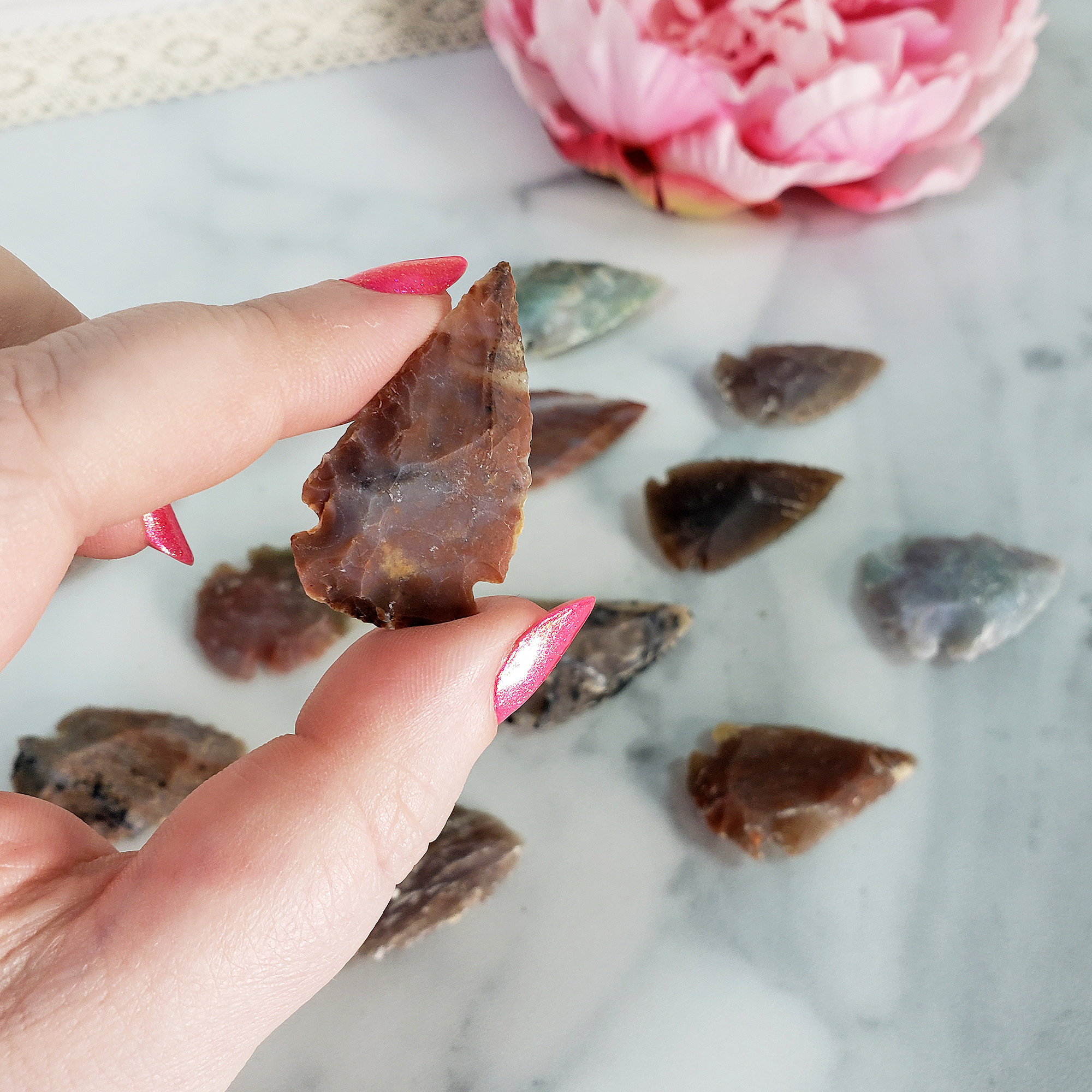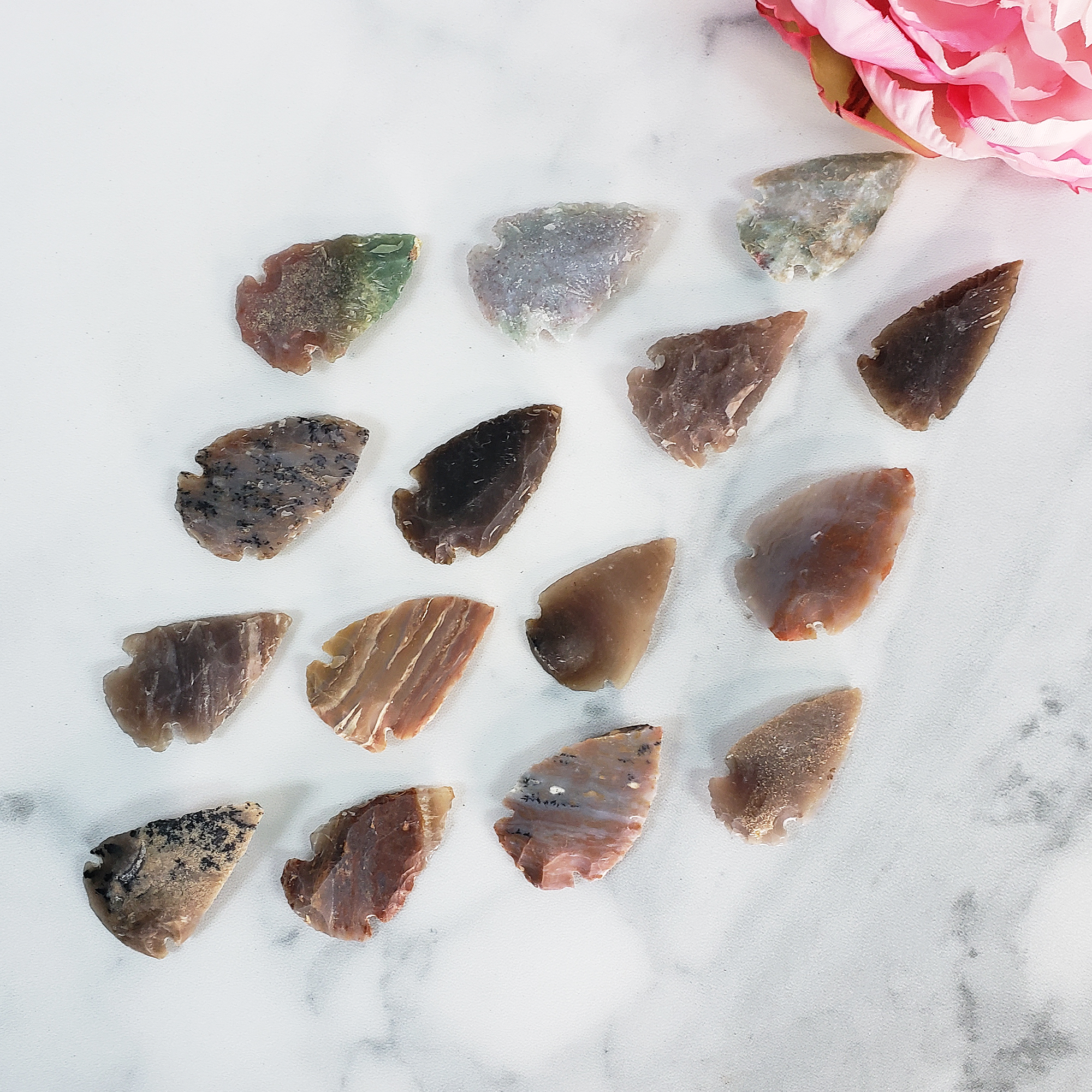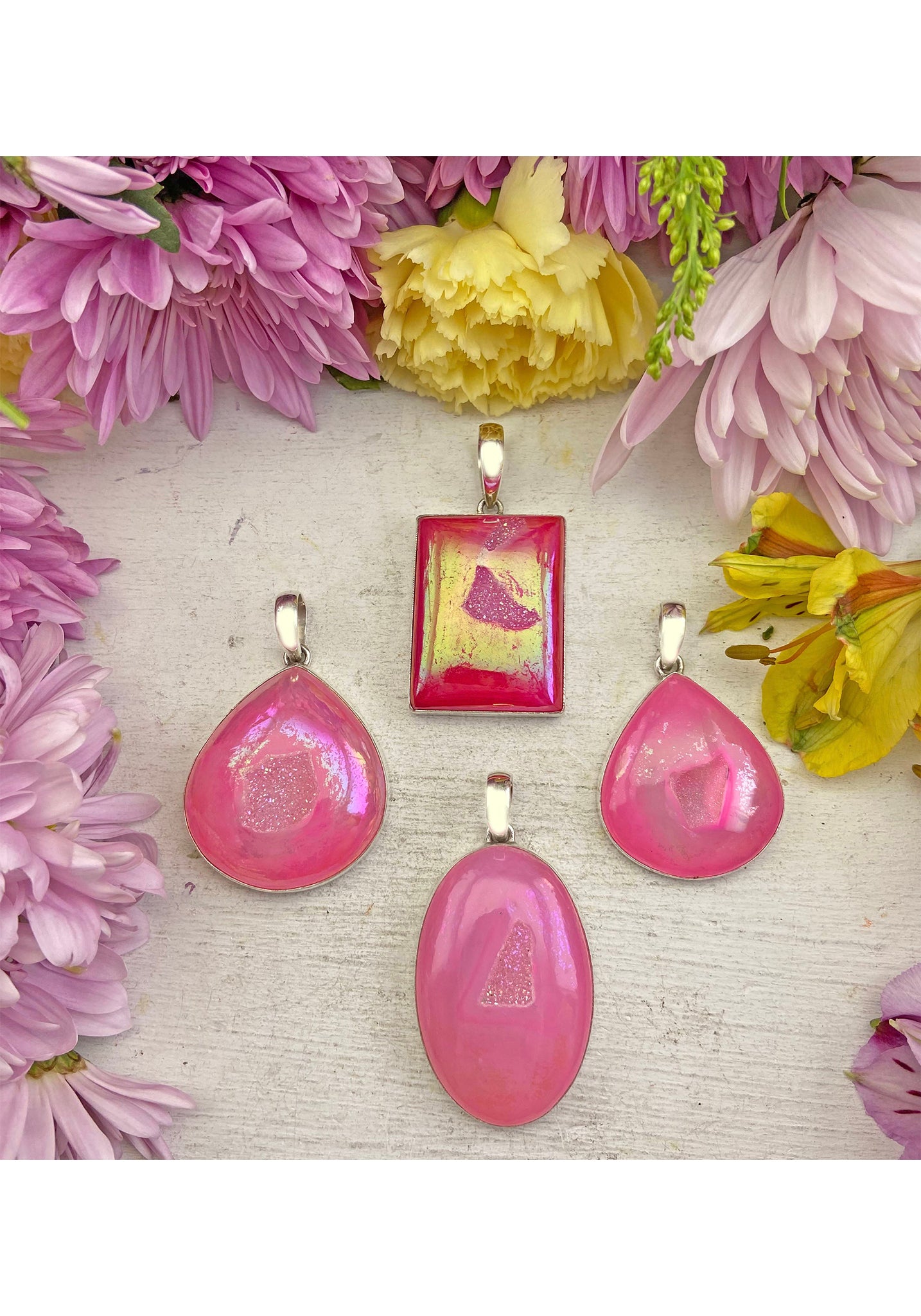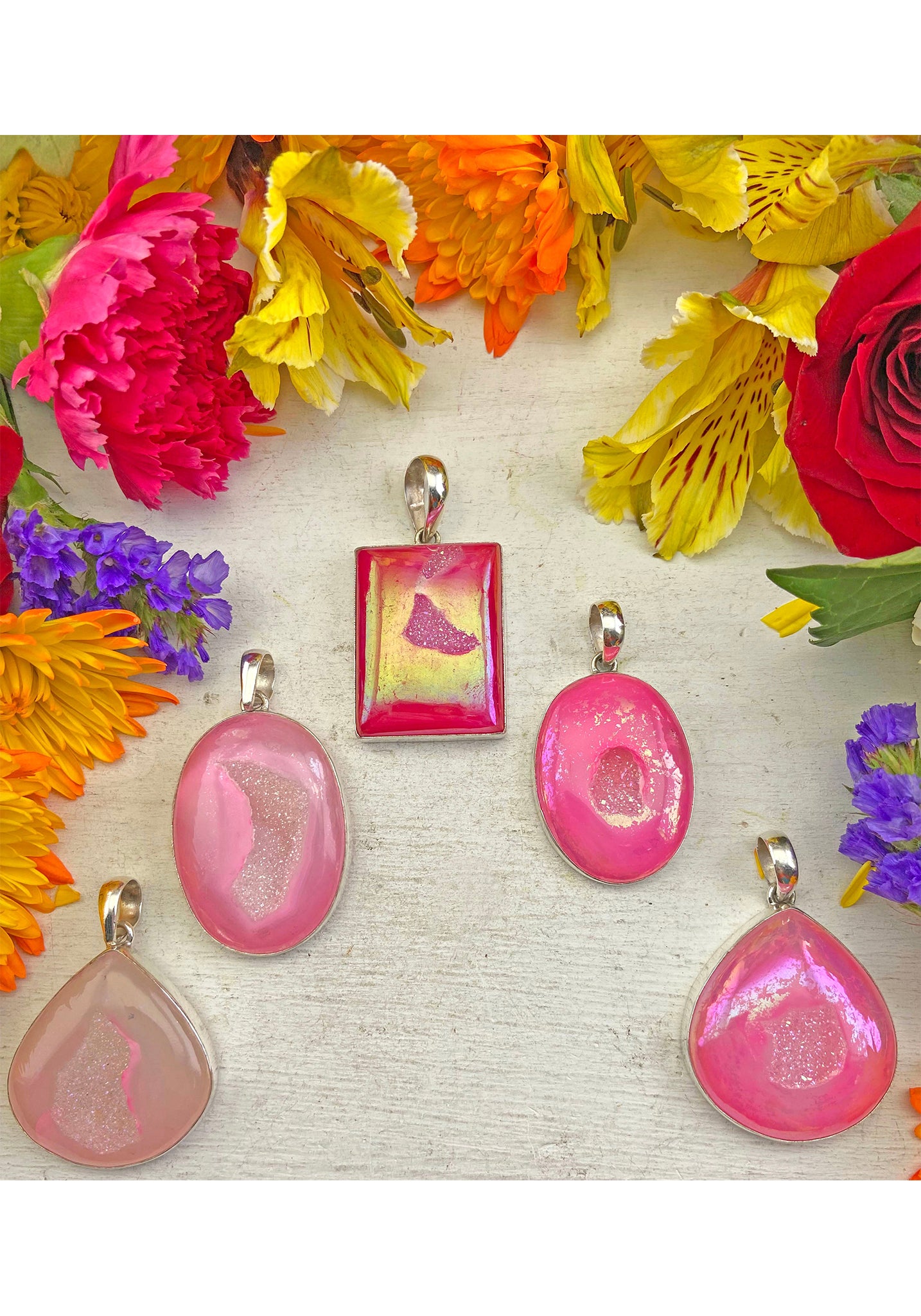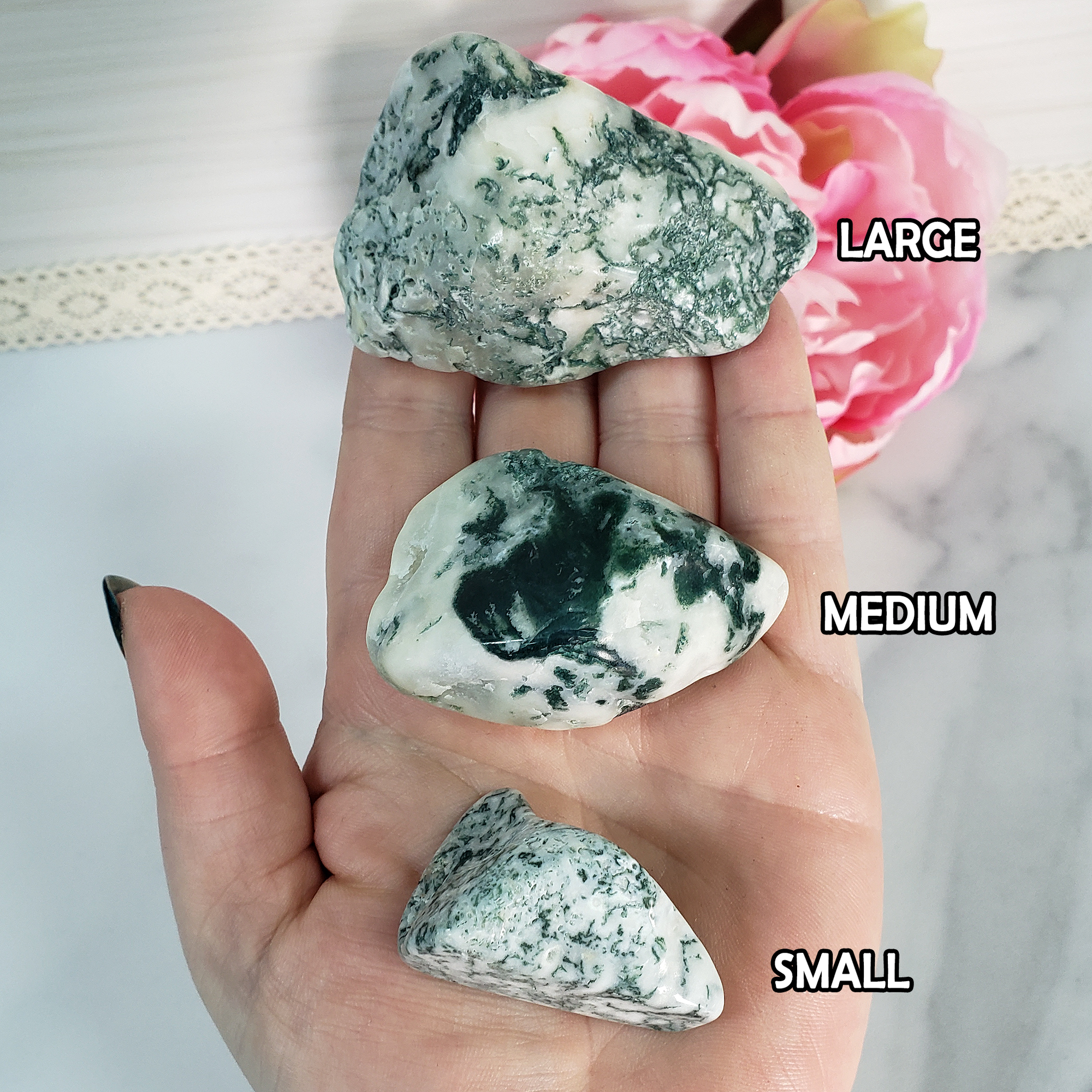What is Agate Crystal Gemstone?
Agate is one of the world's most versatile natural crystals! As a variety of Chalcedony, Agate is known for its wide range of patterns and banding. These stones form in concentric layers, filling cavities in host rock. This process results in agate often appearing as round nodules with concentric bands, much like the rings of a tree trunk. The bands can sometimes resemble eyes, whimsical scallops, or even landscapes with trees.
Some Agate stones derive their patterns from mineral inclusions trapped within, such as the Hornblende and Chlorite inclusions that cause Moss Agate's dreamy green hues. However, banded Agates owe their streaks to periodic changes in translucency and color caused by co-precipitated minerals as well as weathering. Agate crystals may also feature layers of Quartzine, which can cause incredibly striking effects similar to those found in Iris Agate.
Since Agate stones can be found in such a vast number of shades and patterns, varieties are given common names to help with differentiation. Some popular Agate crystals include:
- Bamboo Leaf Agate
- Banded Agate
- Black Agate
- Blue Lace Agate
- Botswana Agate
- Cheetah Agate
- Cherry Blossom Agate
- Crazy Lace Agate
- Dendritic Agate
- Enhydro Agate
- Eye Agate
- Feather Agate
- Fire Agate
- Flower Agate
- Graveyard Point Agate
- Laguna Agate
- Medicine Bow Agate
- Moss Agate
- Oco Agate
- Plume Agate
- Snakeskin Agate
- Tree Agate
- Turitella Agate
- Turkish Agate
- White Agate
While this list may seem quite long, it's only a drop in the bucket compared to the true number of Agate stone varieties in the world. Some are named for their patterning, while others are named for the location where they are most prevalent, but all are little works of art!
The Fascinating History and Origin of Agate Stone
The Agate stone is steeped in history and mythology, tracing its roots back to ancient times. Its name is derived from the Akhates River in southern Sicily, where it was initially discovered. The Greek philosopher Theophrastus, fascinated by this captivating stone, named it in honor of its riverine origin.
Agate has been cherished for thousands of years, weaving its way through various cultures and legends. Some ancient beliefs attributed the stone with the ability to render its wearer invisible, lending it an air of mystique and allure. This magical reputation made it a favored material for jewelry and sacred artifacts in times long past.
Agate in Ancient Cultures
- Celtic Connections: Among the Celts, Agate was associated with the goddess Ceridwen, symbolizing fertility and death. It played a significant role in spiritual and ceremonial practices.
- Egyptian Innovations: In ancient Egypt, Agate was meticulously carved into amulets and decorative objects. Egyptians valued its beauty and believed it provided protection and good fortune.
Agate's Historical Significance
Agate was highly valued as a talisman or amulet in ancient times. It was said to quench thirst and protect against fever, indicating its use as a health-enhancing charm. Persian magicians utilized agate to divert storms, showcasing its role in weather-related rituals and magical practices.
A testament to its esteem is the famous collection of two to four thousand agate bowls accumulated by Mithridates, king of Pontus. This collection reflects the enthusiasm with which agate was regarded, not only for its aesthetic appeal but also for its perceived spiritual and protective powers.
Throughout history, the stone was not only prized for its aesthetic qualities but also for its perceived spiritual and protective powers.
As time progressed, Agate continued to captivate the imaginations of craftsmen and jewelers.
Modern Appreciation
Today, Agate remains a highly sought-after material for artisans creating stunning jewelry and elaborate works of art. Its unique and varied patterns are celebrated in modern ornamentation, highlighting its timeless appeal. Additionally, professionals in the chemical and ceramics industries have found value in Agate, appreciating its durability and beauty.
In summary, the Agate stone carries a rich legacy, transcending its ancient origins to remain a cherished component of both artistic and practical applications worldwide.
The Fascinating Uses of Agate by Persian Magicians and European Royalty
Agate has long been treasured for its mystical and aesthetic qualities. In ancient Persia, magicians held agate in high regard, using it for its reputed ability to fend off storms. These skilled practitioners believed that agate could harness nature’s forces, providing protection and calm during turbulent weather.
Meanwhile, agate’s allure extended beyond its mystical uses. European royalty during the Renaissance displayed a keen interest in this stone, particularly through the art of collecting agate bowls. This practice became a status symbol among the elite, with monarchs amassing impressive collections. The prominence of these collections is evidenced by their preservation and display in notable museums across Europe, such as the Louvre, showcasing the enduring enthusiasm for agate's beauty and historical significance.
The Renaissance and its Impact on Agate Bowls and Ornaments
During the Renaissance, a period characterized by a resurgence in art, culture, and discovery, there was an unprecedented fascination with beauty and craftsmanship. This era ignited a burgeoning interest in agate, a mesmerizing stone celebrated for its vivid colors and intricate patterns.
The Rise of Agate Popularity
-
Cultural Revival: The Renaissance was a time when the elite showed a keen interest in luxurious and exotic materials, driving the demand for unique ornaments.
-
Artistic Appreciation: Renowned artists and craftsmen of the time began to explore the natural beauty of stones like agate, appreciating its aesthetic and tactile appeal.
-
Symbol of Status: Agate bowls and ornaments became symbols of wealth and sophistication, coveted by the affluent as a display of their refined taste and financial standing.
-
Technological Advances: The period's advancements in cutting and polishing techniques allowed agate to be crafted into exquisite bowls and ornaments, enhancing its desirability.
Lasting Influence
The enchantment with agate stones initiated during the Renaissance laid the foundation for an industry that continues to thrive today, with artisans still drawing inspiration from those centuries-old traditions. Thus, the Renaissance's influence on the popularity of agate bowls and ornaments remains unmistakable, transcending its original era and leaving a legacy of craftsmanship and aesthetic appreciation.
Major Locations of Agate Stone Deposits
Agate stones are treasured for their unique beauty and versatility, found across diverse regions around the world. Here’s a breakdown of where the most significant agate deposits can be found:
-
Russia, Germany, and China: These countries boast some of the finest examples of agate stones, known for their striking color patterns and clarity.
-
Eastern and Central Europe: Notable deposits exist in Czechoslovakia and the broader region, offering an array of agate types.
-
North Africa and Asia: Morocco and Mongolia are key locations where high-quality agate is mined.
-
Iceland and India: These regions provide a varied selection of agate stones, each with distinct characteristics.
Key Mining Locations
-
Brazil and Uruguay: Southern Brazil, in particular, is renowned as a prolific source of agate, with extensive mining operations. Uruguay also hosts significant deposits, making South America a major hub for agate extraction.
-
North America: Quebec in Canada is known for its rich agate resources, contributing significantly to the global supply.
-
Asia: Various areas in China have vast mining areas dedicated to extracting these gemstones.
-
Madagascar: Known for its diverse mineral wealth, Madagascar is a crucial player in the agate industry, exporting many varieties to markets worldwide.
In summary, while many regions contribute to the global supply of agate, some of the most abundant and exploited sources are found in Brazil, Canada, China, Uruguay, and Madagascar.
Meaning and Metaphysical Properties of Agate
The spiritual uses and meanings of Agate can be as varied as its appearance, with specific types of Agate being associated with different Chakras, elements, and magical purposes. For example, Moss Agate is considered to be an earth element stone and is traditionally used for spiritual healing, growth, and abundance. However, Crazy Lace Agate is associated with the Solar Plexus Chakra, happiness, and dancing to the beat of one's own drum. Banded Agates are known as a protection stone, especially for travelers. Blue Lace Agate is a stone of mental clarity, honesty, and wisdom.
Since each form of Agate is known for its own traditional healing properties, we're often asked: What about Common Agate? Common Agates feature natural earthy shades of cream, tan, brown, orange, yellow, grey, black, or red, but do not display a distinctive pattern and may not exhibit notable banding unless a strong light is placed behind them. These Agate stones, gorgeous in their own right, are typically associated with the Root Chakra or Sacral Chakra and are used as focal stones by those seeking to embody confidence, strength, motivation, and creativity. Agate crystals are often polished into palm stones for use during meditation or sliced into lapidary stones that can be used to make gemstone jewelry.
How Did Agate Get Its Name?
Agate derives its name from the Greek philosopher Theophrastus, who was struck by the beauty of stones he discovered by the Akhates River in southern Sicily. This connection to both a historic figure and a geographical location has sealed its identity through the ages. Notably, Theophrastus is credited with documenting the stone, which is associated with numerous ancient legends, including the fascinating belief that agate can render its wearer invisible.
How Agate Stone Is Used in Crystal Healing Practices
Agate is renowned for its calming properties, making it a valuable ally in alleviating stress and anxiety. This versatile stone works on both psychological and emotional levels, providing a multi-faceted approach to relaxation.
Calming Your Mind
One of Agate's most notable benefits is its ability to soothe the mind. By promoting tranquility, it helps to dissipate overwhelming thoughts and ease anxiety. Whether you’re facing a stressful work deadline or personal challenges, Agate can bring a sense of calmness and peace, allowing for clearer, more rational thinking.
Enhancing Focus and Clarity
Agate not only helps quiet the chaos in your mind but also enhances concentration. By encouraging rational thought processes, it aids in tackling mental conflicts effectively. This clarity is vital when making decisions, both in day-to-day life and more significant personal or professional matters.
Encouraging Emotional Stability
Beyond mental clarity, Agate is believed to stabilize emotions. This stabilization can ward off negative emotions like fear and anger, replacing them with balanced and harmonious feelings. A more stable emotional state naturally leads to reduced stress levels.
Protection Against Negative Energies
Agate is also seen as a protective stone. Its energy helps to shield you from nightmares and gloom, fostering a more positive outlook on life. This protective quality can make it easier to face daily challenges with a calm demeanor.
By integrating Agate into your life, either through jewelry or as decorative pieces, you can enjoy its stress-relieving benefits while enhancing your environment with its beauty.
How to Crystal Healers Work With Agate
Black Agate serves as a powerful ally in balancing the mind's energies.
- Protective Barrier: It acts as a protective barrier against negative influences, fostering an environment of positive thought and emotional resilience.
- Self-Care: This stone is also valued for its ability to elevate self-confidence, empowering individuals to face challenges with assurance and poise.
- Serenity and Calm: Black Agate nurtures a deep sense of tranquility and peace, aiding in the cultivation of inner serenity.
Green Agate works wonders by nurturing emotional bonds and fostering new connections:
- Strengthening Relationships: For those in relationships, Green Agate is thought to enhance loyalty and trust, fortifying the bond between partners.
- Support for Singles: Singles can also benefit, as the stone is said to open hearts, paving the way to finding a compatible partner.
- Boosting Creativity: In the interpersonal arena, the creativity stimulated by this stone can lead to more vibrant and dynamic relationships.
Pink Agate is more than just pretty, it's a great for crystal healing work with a range of balance:
-
Problem-Solving Energy: This stone is thought to emit a powerful energy that assists in overcoming challenges, making it a useful tool for enhancing problem-solving skills.
-
Calming Center: Many turn to Pink Agate for its calming properties, which may help alleviate stress and encourage relaxation.
-
Boosting Creativity: For those seeking inspiration or needing a creative spark, Pink Agate is said to stimulate creative thinking and innovation.
-
Comfort and Emotional Stability: The stone is cherished for its ability to provide emotional comfort, fostering a sense of peace and stability.
Red Agate is more than a beautiful stone; it's a holistic addition to a crystal healing routine:
- Spiritual Awareness: Providing a sense of grounding, balance, and harmony with your overall spiritual self
- Sensual Center: Bringing a mindful awareness of your needs as a sensual being and pleasure-seeking desires
- Sense of Wonder: Red Agate reminds you to be in a state of wonder with the world around you, and not lose your youthful optimism or hope.
How to Clean and Recharge Agate Stones for Optimal Use
To ensure your Agate stone works at its highest potential, regular cleaning and recharging are crucial. Here's how:
Cleaning Your Agate Stone
- Use Demineralized Water: Immerse your Agate stone in demineralized water. This helps cleanse it of any negative energies it may have accumulated.
- Harness Moonlight: Placing your Agate under moonlight is another effective way to purify it. The calming energy of the moon can naturally cleanse and restore the stone.
Recharging Your Agate Stone
- Quartz Cluster: Position your Agate on a cluster of quartz. This is a powerful way to infuse your stone with energy, as quartz is known for its amplifying properties.
- Amethyst Geode: Nestle your Agate in an amethyst geode. Amethyst is a stone often used to recharge others due to its soothing and revitalizing vibrations.
By following these methods, you can keep your Agate stone cleansed and energized, ensuring it serves your needs effectively.
Uses of Agate in Ancient Civilizations
Agate, a captivating gemstone, played a significant role across various ancient cultures and had a multitude of applications:
-
Jewelry and Ornamentation: Many ancient societies prized agate for its beauty, incorporating it extensively into jewelry and decorative artifacts. Its vibrant colors and intricate patterns made it a popular choice for necklaces, rings, and other adornments.
-
Cultural and Religious Significance: Numerous ancient peoples attributed mystical properties to agate. In certain cultures, it was believed to possess miraculous powers, making it a material of choice for crafting objects used in worship and spiritual rites.
-
Symbol of Fertility and Protection: Among the Celts, agate was associated with Ceridwen, the goddess of fertility and death, symbolizing both creation and passing. This connection highlights its perceived role in life’s cyclical nature.
-
Ancient Egyptian Amulets and Decor: The Egyptians utilized agate not only in fashioning protective amulets but also in creating various decorative items. These artifacts demonstrated both the stone's aesthetic appeal and its believed protective powers.
From luxury to spirituality, agate was deeply woven into the tapestry of ancient life, serving more than just ornamental purposes—it was a symbol of protection, fertility, and divine connection.
The Connection Between Agate and International Trade Success
Throughout history, agate has been much more than just a beautiful stone. Its allure, particularly during the Renaissance, sparked an entire industry focused on crafting exquisite bowls and ornaments. This period marked a blossoming of trade and exploration, tightly intertwining agate with the burgeoning global market.
-
Historical Significance: During the Renaissance, the demand for luxurious goods surged. Agate, with its unique patterns and vibrant colors, became a symbol of wealth and prestige. This demand led to increased trade routes and interactions between different cultures, enhancing global commerce.
-
Symbolism and Belief: Beyond its aesthetic value, many cultures believed agate possessed mystical properties, including the power to attract abundance and success. Merchants and traders would often carry agate as a talisman, hoping it would bring them prosperity in their ventures.
-
Contemporary Impact: Today, agate continues to be a sought-after gemstone in the jewelry and ornament market. Its historical association with trade success has contributed to its enduring popularity, symbolizing not only beauty but also luck and prosperity.
In essence, agate's historical role in fostering international trade and its symbolic significance as a charm for success make it more than just a decorative stone. Its legacy in commerce is robust, linking the past with present-day economic success stories.
What Role Did Agate Play in the Industry Success of Idar-Oberstein, Germany?
Agate played a pivotal role in shaping the gemstone industry of Idar-Oberstein, Germany. The story begins in 1497 when agate mining started in the Nahe River valley. This led to the emergence of Idar-Oberstein as a renowned center for gemstone cutting. Initially, the local river powered the grinding wheels, making it possible for craftsmen to refine agate into beautiful pieces.
However, by the 19th century, the local agate resources were depleted. Undeterred, the skilled artisans turned their attention to Brazil. There, they not only established a new supply chain for agate but also uncovered Brazil's abundant reserves of other valuable gemstones like amethyst, citrine, tourmaline, and topaz. This transition allowed Idar-Oberstein to continue its legacy, expanding its reputation beyond just agate to a variety of precious stones, thereby solidifying its position as a key player in the global gemstone industry.
How Did the Discovery of Brazilian Agate Impact the Gemstone Industry?
The gem-cutting hub of Idar-Oberstein in Germany has a storied history stretching back to the late 15th century, where artisans initially relied on the Nahe River’s agate deposits. This process harnessed the power of the river to operate grinding-wheels, shaping the stones with precision.
However, local agate resources dwindled by the 19th century, prompting a significant shift. Instead of halting their operations, the industrious gem cutters looked beyond Germany’s borders, setting their sights on Brazil. This strategic move was transformative.
Brazil's agate discovery not only rejuvenated Idar-Oberstein's gemstone industry but also unveiled rich troves of other gemstones such as amethyst, citrine, tourmaline, and topaz. This new supply accelerated global interest in Brazilian gems and established the country as a key player in the international gemstone market.
The ripple effects were profound: it expanded the diversity of available gemstones and spurred technological innovations in gem-cutting. Additionally, it solidified lasting trade routes between South America and Europe, ensuring a steady flow of sparkling riches that would captivate jewelers and enthusiasts worldwide.
In summary, the discovery of Brazilian agate didn't just revitalize the industry in Germany but also enriched the global gemstone landscape, underscoring Brazil’s pivotal role in the market.
Idar-Oberstein, a quaint town, has a rich reputation in the contemporary gemstone industry. Historically celebrated for its exquisite agate carvings, it continues to uphold this legacy as a hallmark of craftsmanship. However, its influence now extends globally.
Today, Idar-Oberstein is renowned not only for its skill in agate but also for its expertise in working with a diverse array of gemstones sourced from all over the world. The town imports various gem materials, which are subsequently skillfully cut and intricately carved, both locally in Germany and in collaboration with artisans across Asia.
In essence, Idar-Oberstein is known for blending a deep tradition with international collaboration to maintain its status as a pivotal hub in the global gemstone industry.
What Other Gemstones Were Discovered in Brazil Alongside Agate?
When the agate reserves in the Nahe region were depleted in the 19th century, the skilled gem cutters of Idar-Oberstein turned their attention to Brazil. This shift in focus led to the exploration of Brazil's abundant mineral wealth, resulting in the discovery of numerous gemstones. Alongside agate, explorers uncovered rich deposits of amethyst, citrine, tourmaline, and topaz, as well as other precious stones. These findings significantly contributed to Brazil's reputation as a major source of gemstones.
